Planning a 9-day Ireland itinerary can be a pain in the backside… So, we’ve done all of the hard work for you!
We’ve spent 25+ years travelling around Ireland and the itinerary below leans on that experience and the many mistakes we made along the way!
In a nutshell, this 9-day itinerary:
- Starts and ends in Belfast City
- Has been meticulously planned
- Has an hour-by-hour itinerary for each day to save you time/hassle
- Follows logical routes that take you to hidden gems, tourist favourites and great pubs and restaurants
Who this itinerary will suit
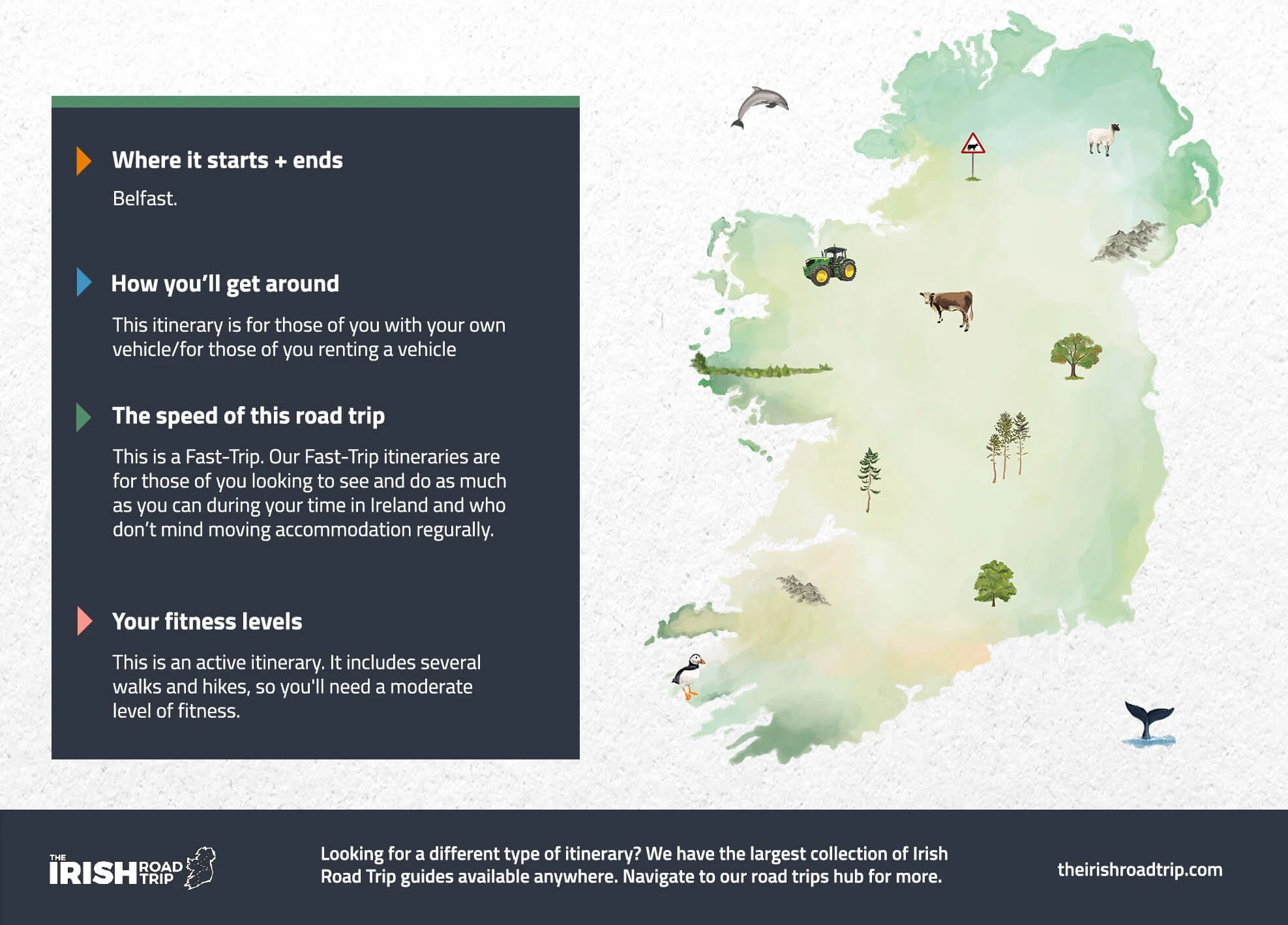
Now, before you scroll down, take 10 seconds to look at the graphic above – each of our road trip itineraries have been tailored to specific needs.
This road trip is specifically for those of you:
- Starting in/near Belfast City
- Using your own car/a rental
- Looking to explore at a fast pace
- With a good level of fitness (i.e. it incudes long walks and hikes)
- Remember, we have hundreds of different itineraries here if this one doesn’t suit you
An overview of this itinerary

The map above gives you a very high-level overview of where this route will take you.
It uses several bases (e.g. Cork for 3 nights) and provides you with day-long road trips you can head off on, so you avoid having to change accommodation constantly.
Now, I’ll stop rambling on – here’s a day-by-day insight into each of the days below!
Day 1: Discovering Belfast City: Northern Ireland’s Capital

Photos via Shutterstock
It’s day one, so welcome to Belfast, the capital of Northern Ireland, and the start point of your epic 9-day tour of Ireland! For today, we’re going to assume that you’ve arrived in the city in the early afternoon, giving you ample time to grab lunch and take in a couple of attractions.
First of all, you’ll probably want to check into your accommodation. You’ll be spending three nights in Belfast, and there are plenty of great hotels and guest houses to choose from. Below, we’ve listed some of our top choices for every budget.
Our Belfast accommodation recommendations
- Budget: Vagabonds Hostel(in the city centre with top reviews) and Amica Guesthouse (short bus/drive from the city centre with great reviews)
- Mid-range: Ten Square Hotel and Maldron Hotel Belfast City (both are super central with exceptional reviews)
- Luxury: The Fitzwilliam and The Merchant (both gorgeous, high-end hotels at the heart of the action)
Stop 1: Lunch

Photos via The Lamppost Cafe on FB
You’ll probably have a mighty hunger after all that travelling. Fortunately, there’s no shortage of stunning places to eat out, especially in the city centre. So, first things first, head to the heart of town. Once you’re there, you’ll find no end of cafes, restaurants, and pubs that are sure to satisfy your hunger.
Almost any good pub will do traditional Irish fayre, so if you’re looking for gorgeous soda bread, seafood, stews, and much more, you’ll have plenty of choices. Burger fans should definitely check out Bunsen on Hill Street. With a small, carefully curated menu, you can’t go wrong. Blu is another great choice, with a sleek and modern menu that caters to everyone, although for us, it’s hard to resist the steaks!
Stop 2: Crumlin Road Gaol

Photos via Shutterstock
After a good feed, it’s time to take in some local attractions. Crumlin Road Gaol is a leisurely 16-minute walk away from the city centre, so there’s no need to take the car if you don’t want to. If you do prefer to drive, it’ll take about 10 minutes or so.
The self-guided tour takes you on a 70-minute journey through the tunnels and corridors that make up the 150-year-old prison. Complete with information boards and videos, you’ll get to see various parts of the old gaol, including the holding cells, execution chamber, and the prison graveyard.
Stop 3: Belfast Black Cab Tour
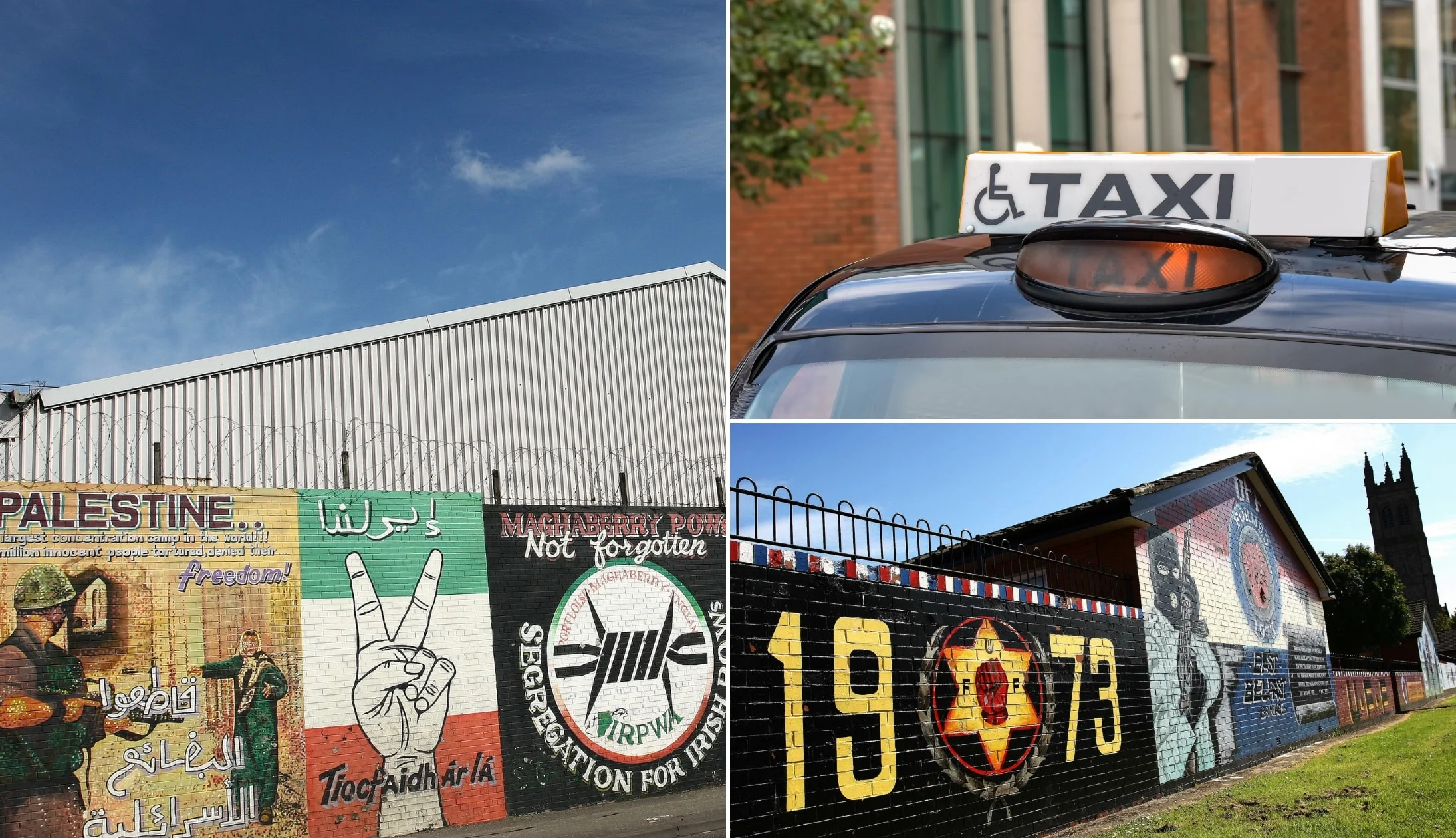
Photos via Shutterstock
The Belfast Black Cab tour offers an incredible experience that shouldn’t be missed. Each of the tour guides lived through the Troubles, lending real-life experience to the tours. You’ll pass through various parts of Belfast that you might not feel comfortable visiting by yourself. All the while, your guide will regale you with stories and first-hand accounts of the history behind each place.
You’ll also see a lot of fantastic murals and other sights, like the iconic Belfast Peace Wall. It’s a great way to learn more about Belfast’s long, rich, and sometimes sad history. Tours depart from the Jury Inn on Victoria Road, which is about a 23-minute walk from Crumlin Road Gaol.
Stop 4: Titanic Belfast
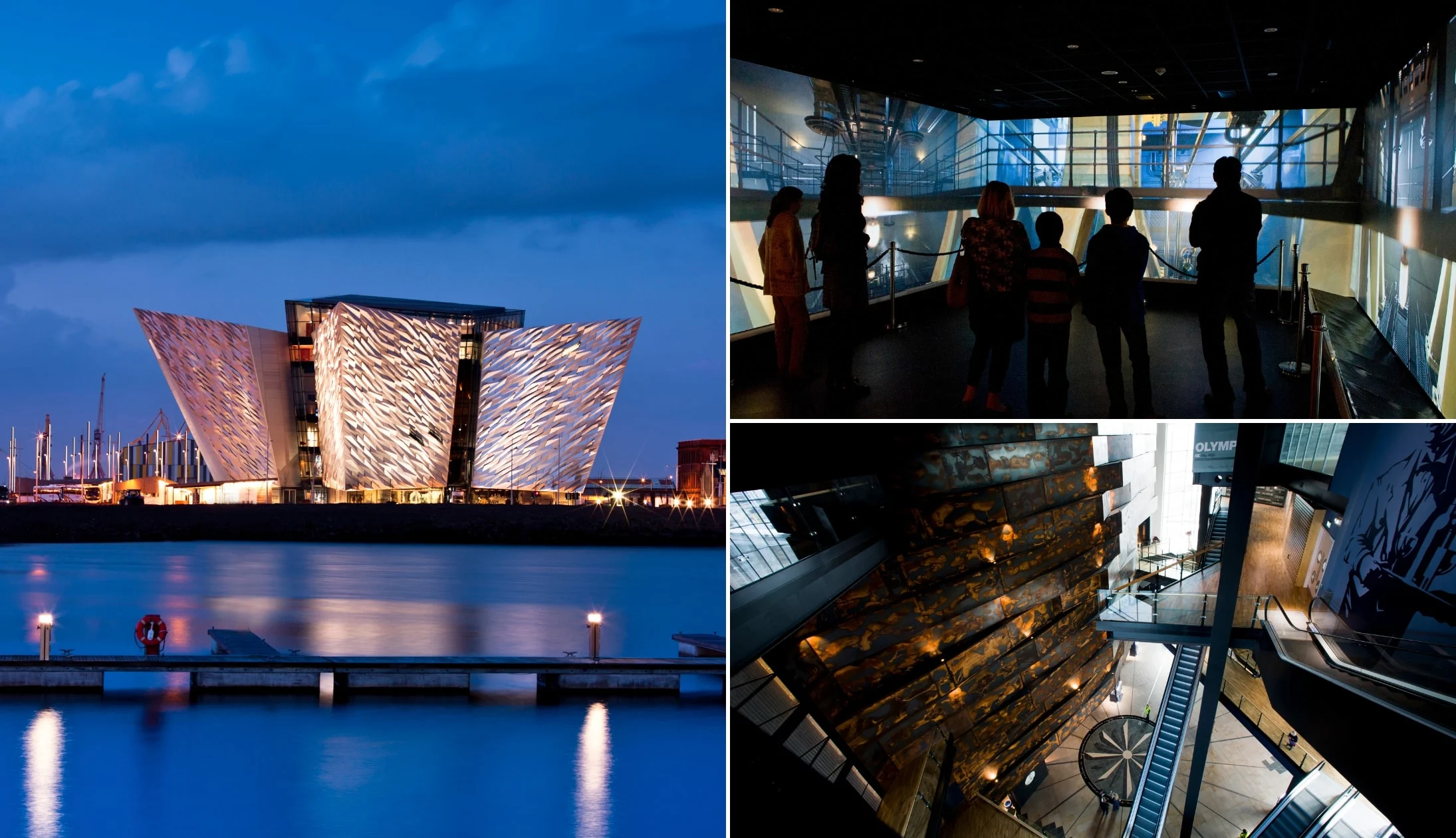
Photos by Chris Hill via Tourism Ireland
At the end of the Black Cab Tour, you’ll be dropped off back in the Cathedral Quarter, in the heart of the city. From here, you can walk to the Titanic Experience in about 25 minutes or drive there in about 10. Alternatively, the Glider (G2 line) will also take you there.
The Titanic Experience is one of Belfast’s most popular attractions. Located right on the slipways where RMS Titanic was designed, built and launched, the enigmatic Titanic Museum tells the now-infamous story incredibly well. Visitors can expect exhibits, replica staterooms, photos, documents and 21st-century technology. You’ll see, hear and even SMELL the shipbuilding process during your tour!
Stop 5: Dinner, drinks and live music

Photo left: Silvia Franceschetti (CC BY-SA 3.0). Others via Bittle’s Bar on FB
You’ll find tons of options for food, drink, entertainment, and plenty of live music back in the Cathedral Quarter, so whether you go back to your accommodation to freshen up first or head straight out is up to you.
Our Belfast food recommendations
There’s some outstanding restaurants in Belfast City. First up, Deanes is a Belfast institution and a must-visit while you’re in the city. There are three venues to choose from, each focusing on something different; Deanes Meat Locker, Deanes Love Fish, and Deanes at Queens.
Whichever you choose, you’re in for a fine feed. EDO is another favourite of ours, a stunning tapas and cocktail bar with incredible sharing platters.
Or, for a fancy first meal in Ireland, head to The Ginger Bistro, near the Belfast Opera House. Their menu is out of this world, though that’s no surprise when you consider it was voted the best restaurant in Northern Ireland.
Our Belfast pub recommendations
There are countless incredible pubs and bars in Belfast for a tasty after-dinner tipple. Check out traditional options like the unmistakable Bittles Bar, with its stunning range of local beer and Irish whisky.
The Duke of York is another old-school boozer, walls adorned with knick-knacks from yesteryear and serving up a fine pint of Guinness.
Finally, we couldn’t forget Madden’s Bar, a cosy, traditional pub complete with a roaring wood-burning stove and a friendly atmosphere. Somewhat overlooked, it’s a hidden gem, beloved by those in the know!
Traditional musicians from across Ireland come to play at Kelly’s Cellars every Tuesday, Wednesday, Thursday, and Saturday.
Other fantastic options for music include Fibber Magees, another charmingly old-fashioned pub with a lively atmosphere, and the John Hewitt.
Day 2: The Causeway Coast

Photos via Shutterstock
After a fantastic first day enjoying the sights of the city, it’s time to hit the road and check out the incredible Causeway Coastal Route.
Of course, the highlight is the epic Giant’s Causeway, which you’ll get the chance to see up close and personal before heading back to Belfast for dinner and entertainment. But first…
You’ve got an action-packed day ahead of you, so it’s a good idea to get a hearty breakfast in you before you start! Grab a full Irish or buffet breakfast at your accommodation, or head into town to check out one of the many superb cafes.
We’d heartily recommend the Lamppost Cafe on Newtownards Road for a slap-up cooked Irish breakfast—they also have a cooked vegan breakfast. Alternatively, check out the Grapevine in the Cathedral Quarter for porridge, bagels, baps, and breakfast burritos.
Stop 1: Carrickfergus Castle
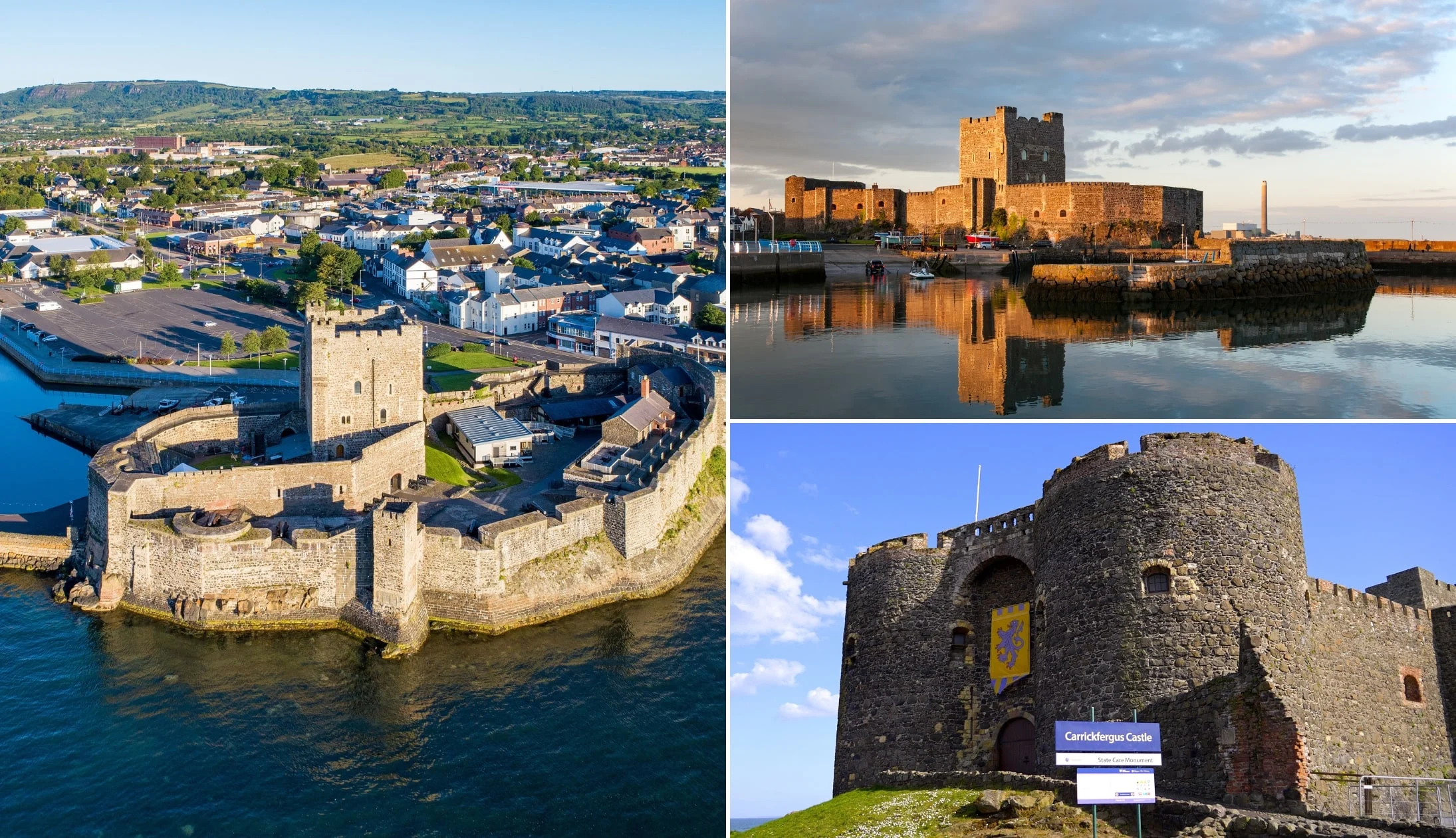
Photos via Shutterstock
Carrickfergus Castle is one of the most well-known and best-preserved castles in Ireland. It’s just a 23-minute drive from Belfast City Centre, making it an ideal first stop on your way to the Causeway Coast.
Dating back to the 12th Century, this epic fortress boasts huge walls that protect it from the sea, plus a number of mighty towers. It’s been the site of countless battles over the years and it’s no surprise that it’s home to a ghost. The guided tour is well worth the ticket fee, although with numerous information boards and displays, you can also enjoy a self-guided tour at your own pace.
There’s a large car park right next to the castle and the harbour. It’s free to use, has public toilets, and it’s just a short walk to the castle gates. If you fancy a little pick-me-up before you jump back in the car, NACS coffee shop is also nearby and they serve up a superb cup of coffee as well as cakes and snacks.
Stop 2: Whitehead Coastal Path – Blackhead Lighthouse
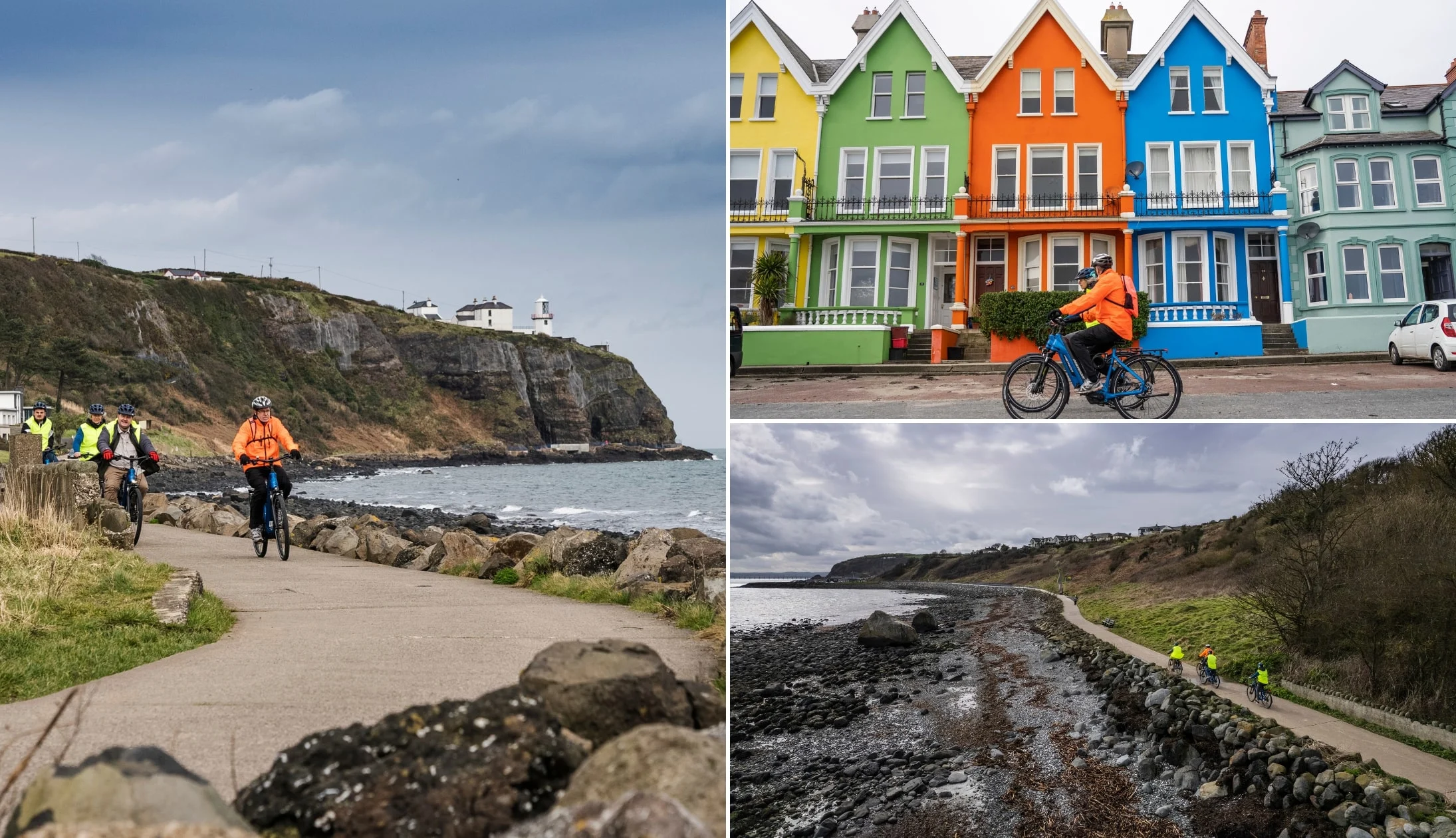
Courtesy of Mid and East Antrim council @grafters media
Stop number two is just 13 minutes away from Carrickfergus Castle and offers a nice, short walk along the beautiful coastline out towards Blackhead Lighthouse. It’s an excellent opportunity to stretch your legs and feel the sea breeze on your face while taking in the spectacular scenery. Looking out to sea, you might see a pod of dolphins frolicking in the waves, seals, seabirds, and, if you’re really lucky, the occasional minke whale.
As you amble along the coast, you’ll take in breathtaking sea caves before reaching the beautiful lighthouse. It’s a bit of a climb up there, with more than 100 steps, but it’s worth the effort for the views. Built in 1902, it has guided many famous ships in its time, including the Titanic.
The walk is about 5 km in total. Simply park up in the Whitehead Car Park and follow the paved track up to and around the lighthouse before returning back the same way.
Stop 3: The Gobbins

Photos via Shutterstock
Just a 5-minute drive from White Head, you’ll arrive at the Gobbins Cliff Path. First opened way back in 1902, it was originally aimed at Edwardian thrill-seekers that wanted to experience a chunk of Ireland’s most dramatic coastline up close. It’s a tough 3-mile/5km or so walk with steep inclines and declines that are said to be the equivalent of climbing 50 flights of steps.
But the rewards are well worth it, with spectacular views as you cross swinging bridges, pass through eerie tunnels beneath the sea, and enjoy epic cliff-top views. You’ll need a decent level of fitness, and to avoid disappointment, it’s best to book ahead and arrive 15 minutes before your walk kicks off. The Gobbins admission fee is £20 for an adult, £14.50 for kids under 16, OAPs (65+) and students. There’s also a family ticket (2 adults and 3 kids) for £42.
Stop 4: The Black Arch
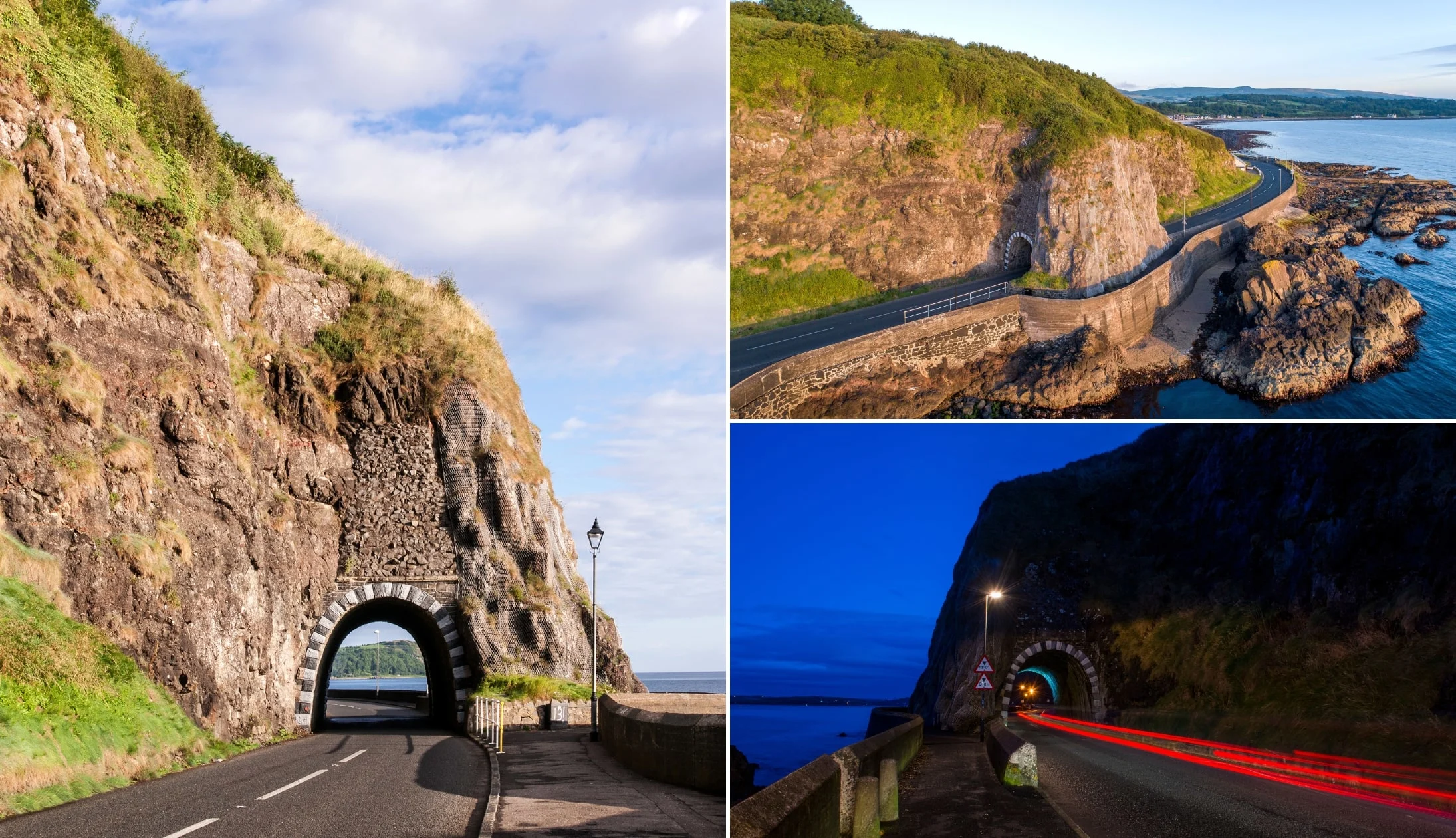
Photos via Shutterstock
The epic Black Arch isn’t really a stop in itself. It’s actually just a short tunnel that you’ll drive through as you cruise along the Antrim Coast Road. The road clings to the sea, with cliffs looming up on the other side.
As you approach Larne, about 20 minutes from The Gobbins, the craggy cliffs cross over the road, which tunnels through. It’s only short, but it looks pretty cool and is a popular spot for photographers.
Stop 5: Cushendun Beach

Photos via Shutterstock
The coast road is absolutely stunning between the Black Arch and your next stop, Cushendun Beach. This lovely sandy bay is a fantastic place to relax and gaze out across the sea.
On a clear day, you might even see the Scottish Coast. If you fancy stretching your legs, it’s worth walking to the nearby Cushendun Caves, which are famous for appearing in the Game of Thrones series. Alternatively, there’s a 2km looped walk around the beach and village.
It’ll take about 48 minutes to reach Cushendun Beach from the Black Arch, and there’s plenty of free parking to be found, as well as public toilets.
Stop 6: Lunch in Ballycastle

Photos via Central Bar Ballycastle on FB
After a short 22-minute drive from Cushendun Beach, you’ll arrive in the bustling seaside town of Ballycastle. The town boasts a gorgeous location, surrounded by sea, sand, mountains, and forests, and is ideally placed on the Antrim Coastal Route. The former Viking settlement is a top spot for a bit of lunch too.
Morton’s Fish and Chips is our favourite place for a bite to eat. It’s right on the harbour, with a small car park next to it. The food is great, and on a fine day, there are few things better than sitting on the harbour wall watching the boats go by with a nice hot bag of fish and chips. If you’re looking for something other than chipper food, check out the Central Bar. Their menu boasts a fine selection of fresh seafood, steaks, and much more.
After lunch, there’s plenty to see and do in Ballycastle, including various craft shops, the beach, or simply wandering about town. If you’re there on the last Tuesday in August, you can also check out the Old Lammas Fair.
Stop 7: Carrick-a-Rede

Photos via Shutterstock
The next stop is just 11 minutes outside of Ballycastle. Carrick-a-Rede is a small island just off the Causeway Coast. It’s attached to the mainland by an old rope bridge and was once a top spot for salmon fishing. Nowadays, you can enjoy a short coastal walk that culminates in crossing the bridge.
Swinging 25 feet above the sea as it crashes against the rocks below, it’s not great for those with a fear of heights! The entire walk will typically take an hour or so in total and offers spectacular views and a thrilling experience. We recommend checking the bridge out in the off-season rather than the height of summer, as it does get busy.
Stop 8: Giants Causeway

Photos via Shutterstock
After the dizzying heights of Carrick-a-Rede, you’ll arrive at the epic Giant’s Causeway in about 18 minutes. This legendary landscape boasts more than 40,000 basalt pillars, jutting proudly out from the sea. In Irish folklore, the path was used by the hero Fionn Mac Cumhaill to get to Scotland, where he fought an enemy giant.
It was formed more than 60 million years ago and has been studied by geologists for more than 300 years, making it one of the most important and unique nature reserves on earth. Now, parking at the Giant’s Causeway Visitor Centre is the most convenient but also extremely expensive. A more affordable alternative is to park at the nearby Causeway Coast Way Car Park and walk down.
You can easily spend a couple of hours at the Giant’s Causeway, especially if you do decide to check out the visitor centre. Just be advised it can be crazy busy on weekends and during the high season.
Stop 9: Bushmills

Photos courtesy of Tourism Northern Ireland
Once you’ve finished exploring the Giant’s Causeway, your next stop is just a quick 9-minute drive away. The small, riverside town of Bushmills is home to some great pubs and shops, and it’s a nice place to wander around.
However, the Bushmills Distillery is the highlight and well worth a visit. The oldest licensed distillery in the world, you don’t have to be a whiskey drinker to enjoy a tour of the facilities, though it doesn’t hurt if you do enjoy a wee dram every now and then!
Along the 40-minute tour, you’ll get a chance to see, smell, and hear how Irish whiskey is made in the company of a knowledgeable tour guide. The tours are a good laugh, culminating in a fantastic tasting session. Having said that, it’s better to take some samples with you if you’re driving.
Stop 10: Dunluce Castle
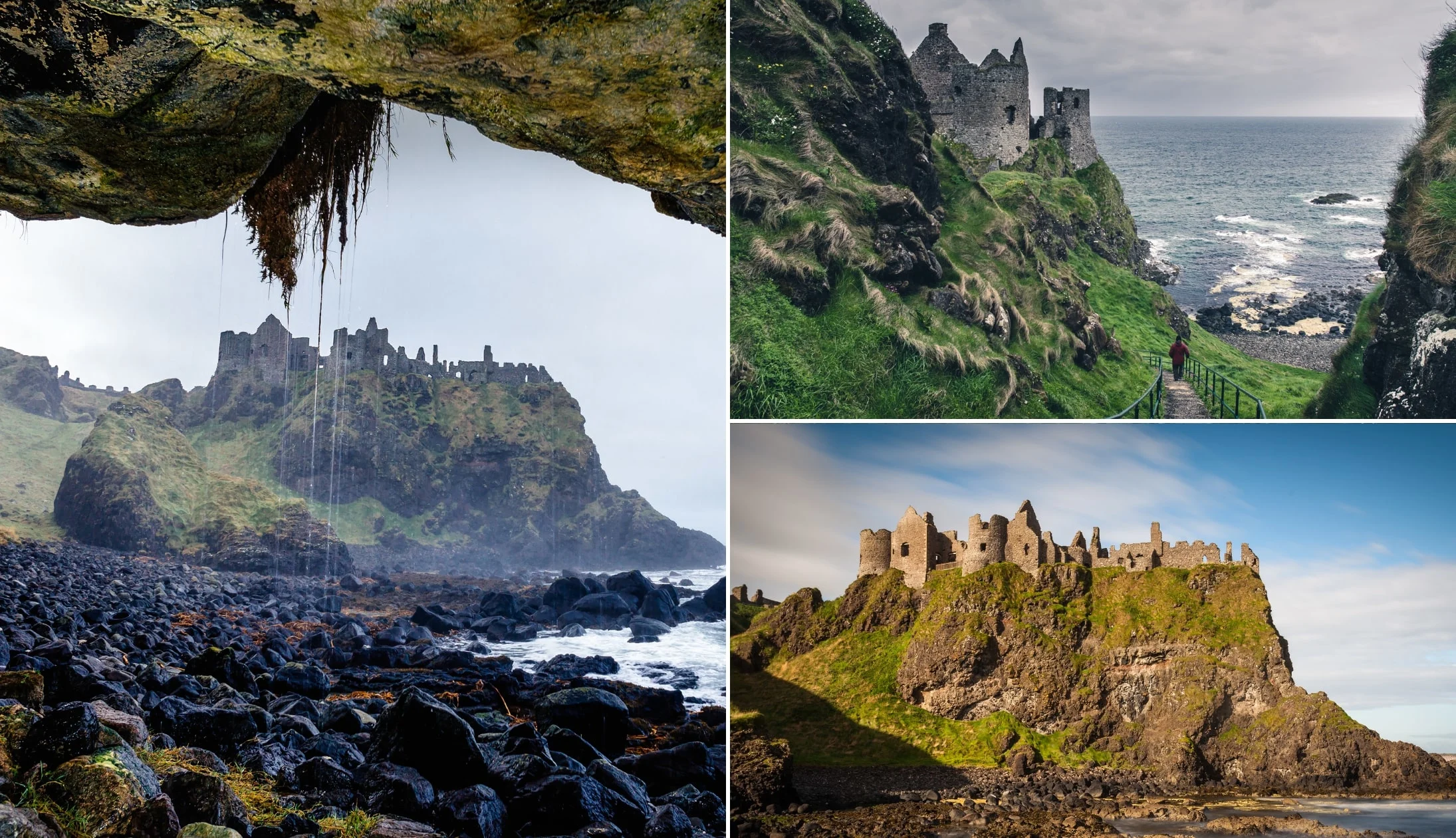
Photos via Shutterstock
Our final stop for the day, before returning to Belfast, is the legendary Dunluce Castle. It’s just a 7-minute drive from Bushmills and a wander around the castle ruins is well worth it. Dunluce Castle dates back to the 1500s and is rich in history.
Of course, there are several legends, most notably the Dunluce Banshee, whose wails and screams are said to haunt the Northeast Tower. It’s another top spot for Game of Thrones fans, too—the castle served as the Greyjoy fortress on the Iron Isles.
You can enjoy a guided or self-guided tour of the grounds, or if you prefer not to go in, you can enjoy viewing it from afar at a nearby viewpoint.
Stop 11: Back to Belfast for the night

Photo left: Silvia Franceschetti (CC BY-SA 3.0). Others via Bittle’s Bar on FB
Taking a more direct route back will have you in Belfast in about an hour and 15 minutes or so.
You’ll find tons of options for food, drink, entertainment, and plenty of live music here, so whether you go back to your accommodation to freshen up first or head straight out is up to you.
Our Belfast food recommendations
There’s some outstanding restaurants in Belfast City. First up, Deanes is a Belfast institution and a must-visit while you’re in the city. There are three venues to choose from, each focusing on something different; Deanes Meat Locker, Deanes Love Fish, and Deanes at Queens.
Whichever you choose, you’re in for a fine feed. EDO is another favourite of ours, a stunning tapas and cocktail bar with incredible sharing platters.
Or, for a fancy meal , head to The Ginger Bistro, near the Belfast Opera House. Their menu is out of this world, though that’s no surprise when you consider it was voted the best restaurant in Northern Ireland.
Our Belfast pub recommendations
There are countless incredible pubs and bars in Belfast for a tasty after-dinner tipple. Check out traditional options like the unmistakable Bittles Bar, with its stunning range of local beer and Irish whisky.
The Duke of York is another old-school boozer, walls adorned with knick-knacks from yesteryear and serving up a fine pint of Guinness.
Finally, we couldn’t forget Madden’s Bar, a cosy, traditional pub complete with a roaring wood-burning stove and a friendly atmosphere. Somewhat overlooked, it’s a hidden gem, beloved by those in the know!
Traditional musicians from across Ireland come to play at Kelly’s Cellars every Tuesday, Wednesday, Thursday, and Saturday.
Other fantastic options for music include Fibber Magees, another charmingly old-fashioned pub with a lively atmosphere, and the John Hewitt.
Day 3: Exploring the Mourne Mountains

Photos via Shutterstock
Day three sees us exploring the majestic Mourne Mountains in the southeast part of Northern Ireland. An epic landscape of towering peaks, lush forests, and tranquil lakes, it’s a fantastic place for hiking and enjoying some of the best scenery in Ireland. We’ll start the day by exploring the Silent Valley, before climbing the highest peak in Northern Ireland.
We’ve got quite an active day lined up, so you’ll want to grab a hearty breakfast at your accommodation or in a nearby cafe. We’d recommend Established Coffee on Hill Street for a decent selection of cooked breakfasts, great coffee, and pastries. Alternatively, The Pocket on Upper Church Lane does a stunning full Irish fry-up and a bunch of veggie and vegan options.
Once you’ve had a good feed, it’s worth stocking up on water and snacks, as you’ll be spending the morning in the mountains.
Stop 1: The Silent Valley
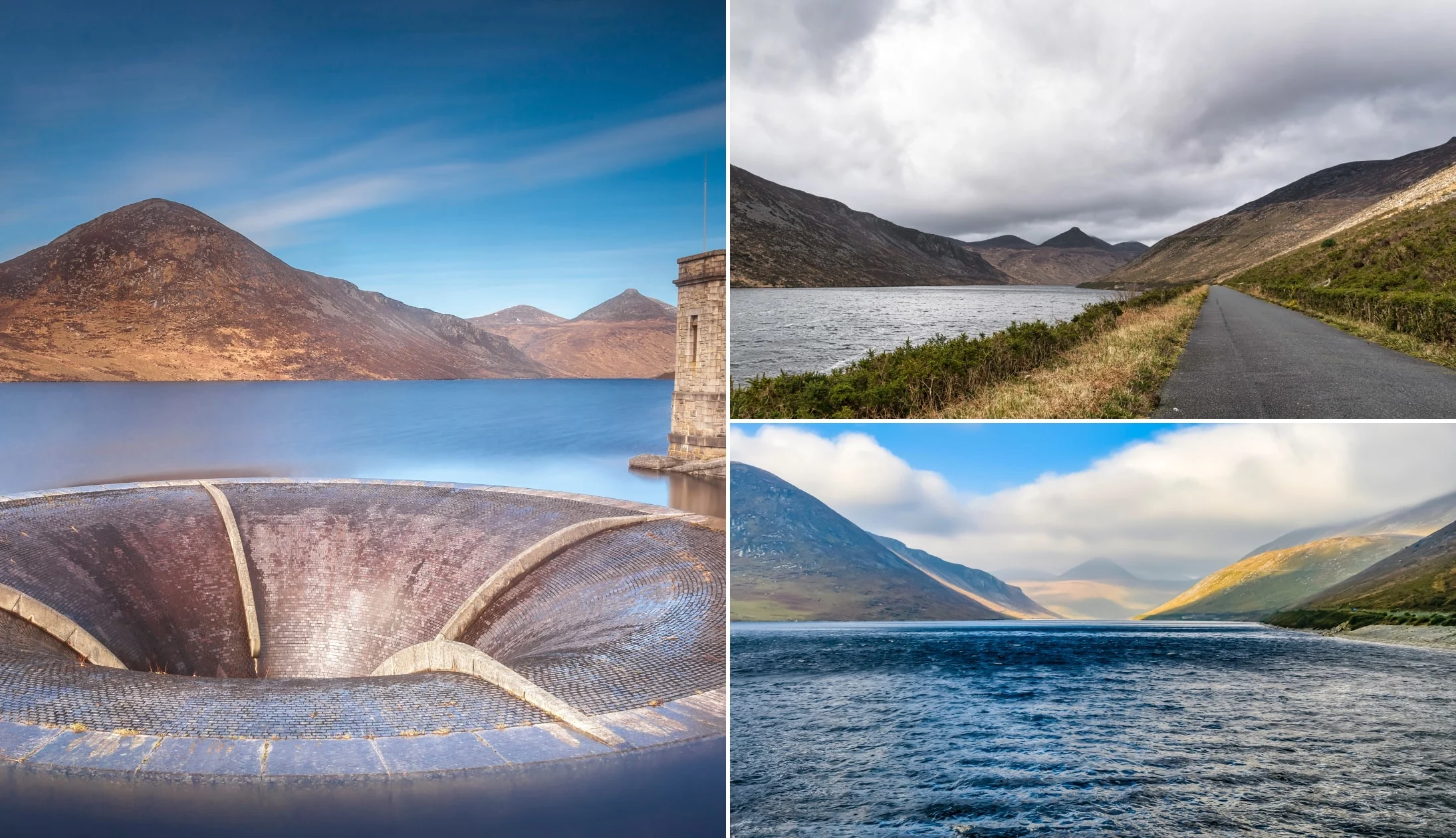
Photos via Shutterstock
Our first stop is just over an hour south of Belfast. The Silent Valley is an incredibly scenic reservoir that sits amid the mighty Mourne Mountains. The views are out of this world, and there are several walks you can take to explore the area.
We suggest following the Nature Trail, a short but sweet 1.8 km loop that circles the Kilkeel River, along a boarded walkway. It’s easy-going and shouldn’t take too long to complete. There are other walks in the area, but you might want to preserve your energy for our next stop.
As well as the views, the reservoir is steeped in history and tells a story of determination and human mastery over an unforgiving environment. You can learn more from the information panels or by visiting the visitor centre. Prices for the Silent Valley car park vary: Car: £5, Coach: £35, Minibus: £13, Motorcycle: £2.50, On foot: £1.60 per adult and £0.60 per child
Stop 2: Slieve Donard
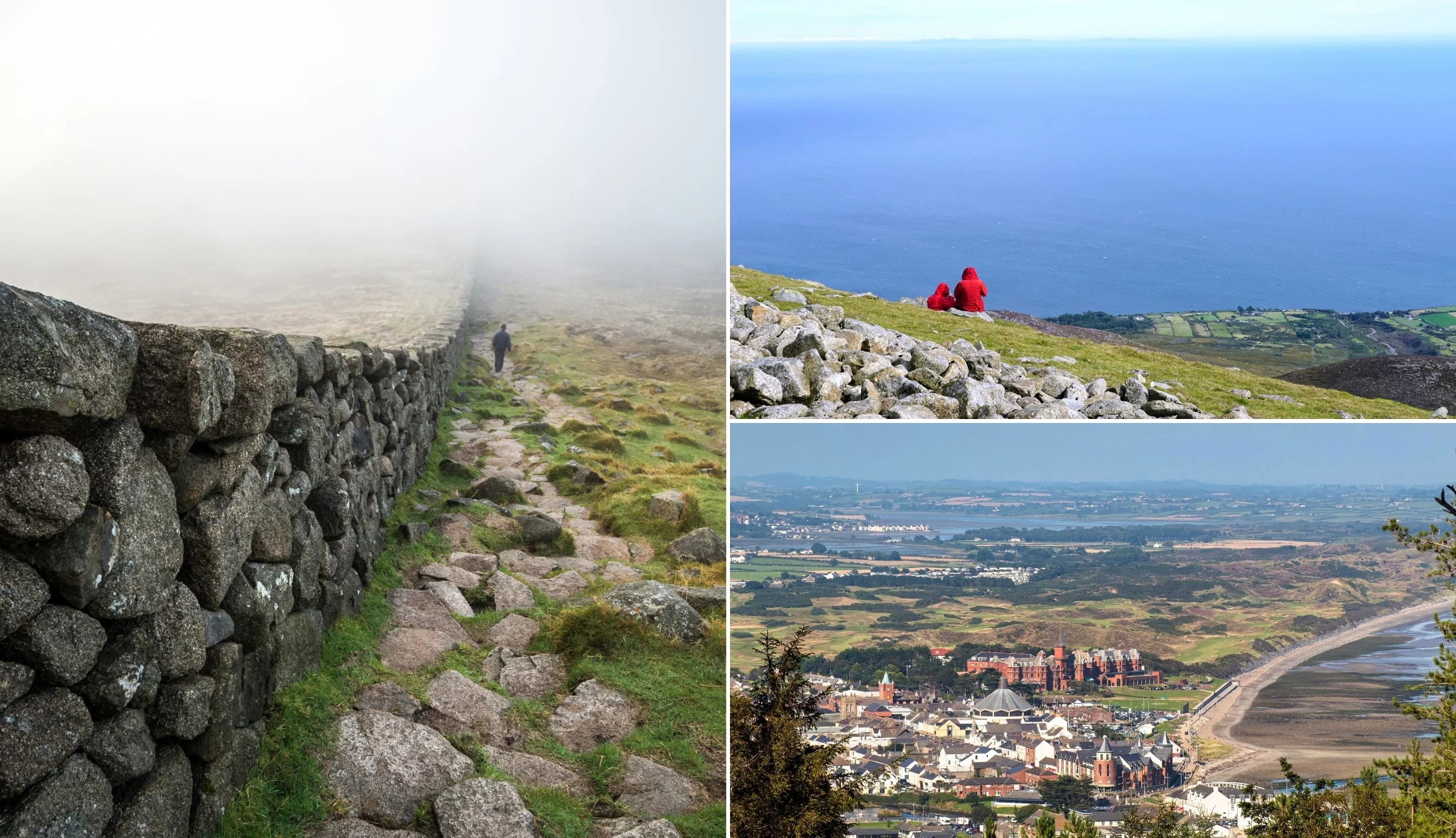
Photos via Shutterstock
Donard car park is free to use and is located in the town of Newcastle, and from there the trail up to the summit of Slieve Donard is easy enough to pick up. It’ll take about 25 minutes to get here from Silent Valley.
At 850 metres, Slieve Donard is the tallest mountain in Northern Ireland, and the hike to the summit is moderate to strenuous, with several steep climbs along the way. It’s challenging but rewarding, and anyone with a reasonable level of fitness should be okay. The linear walk measures 4.6 km each way (9.2 km in total) and generally takes about four to five hours to complete.
The views from the summit are absolutely spectacular, especially on a fine day when you can see for miles all around. Once you’ve enjoyed the views, head back down the way you came up, just in time for a well-earned lunch.
Stop 3: Lunch in Newcastle
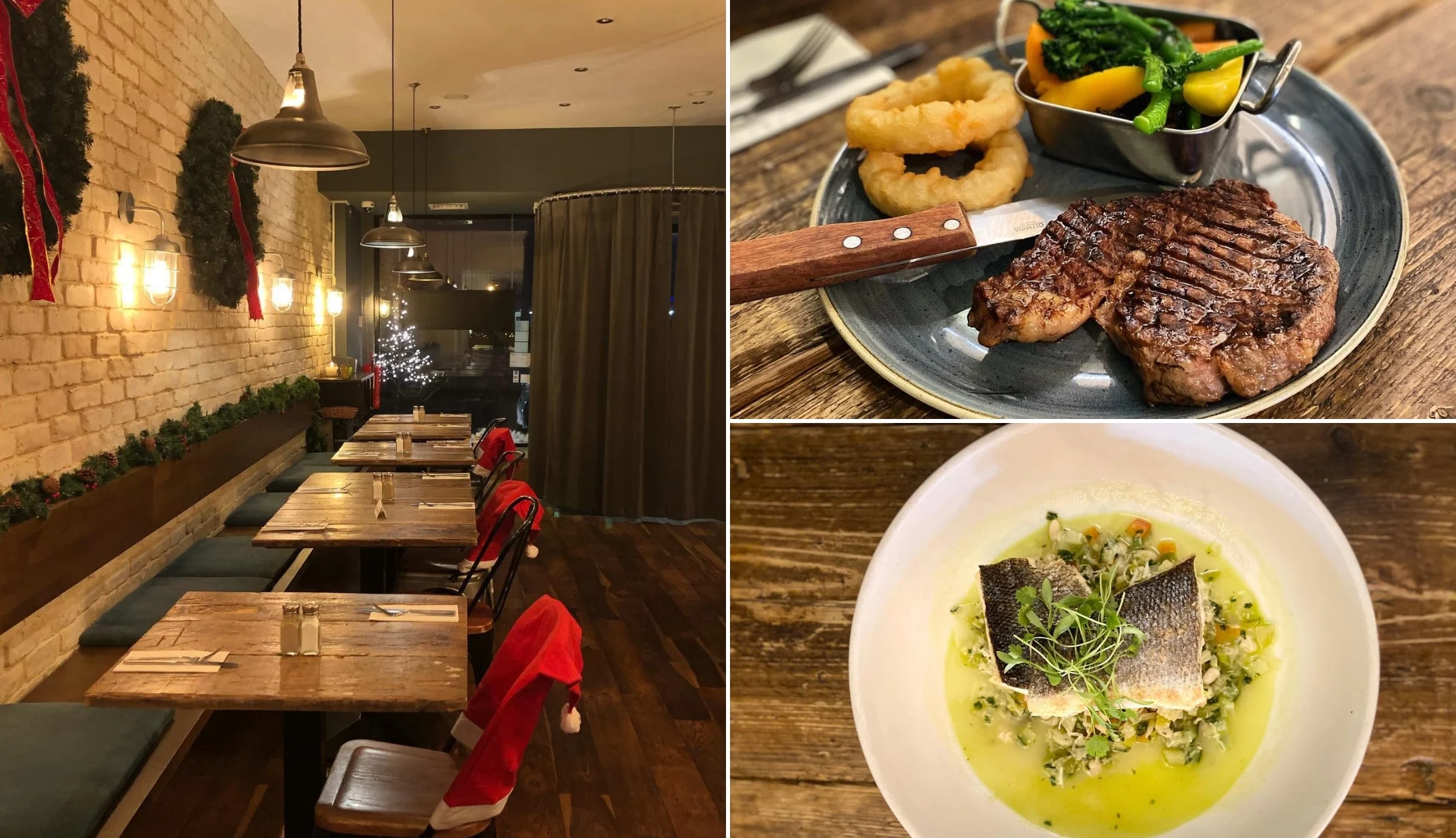
Photos via Great Jones on FB
You can leave your car parked in the same car park and walk to a number of superb restaurants and cafes in Newcastle.
Quinns Bar is about a ten-minute walk from the car park, in the heart of Newcastle. They offer a varied menu and big portions, so you can be sure of a good feed. Just down the road, you’ll find Great Jones, which is another top pick.
Alternatively, Nikki’s Kitchen Cafe is just around the corner from the car park and offers up a wealth of sandwiches, wraps, and cooked cafe classics.
Stop 4: Newcastle Beach
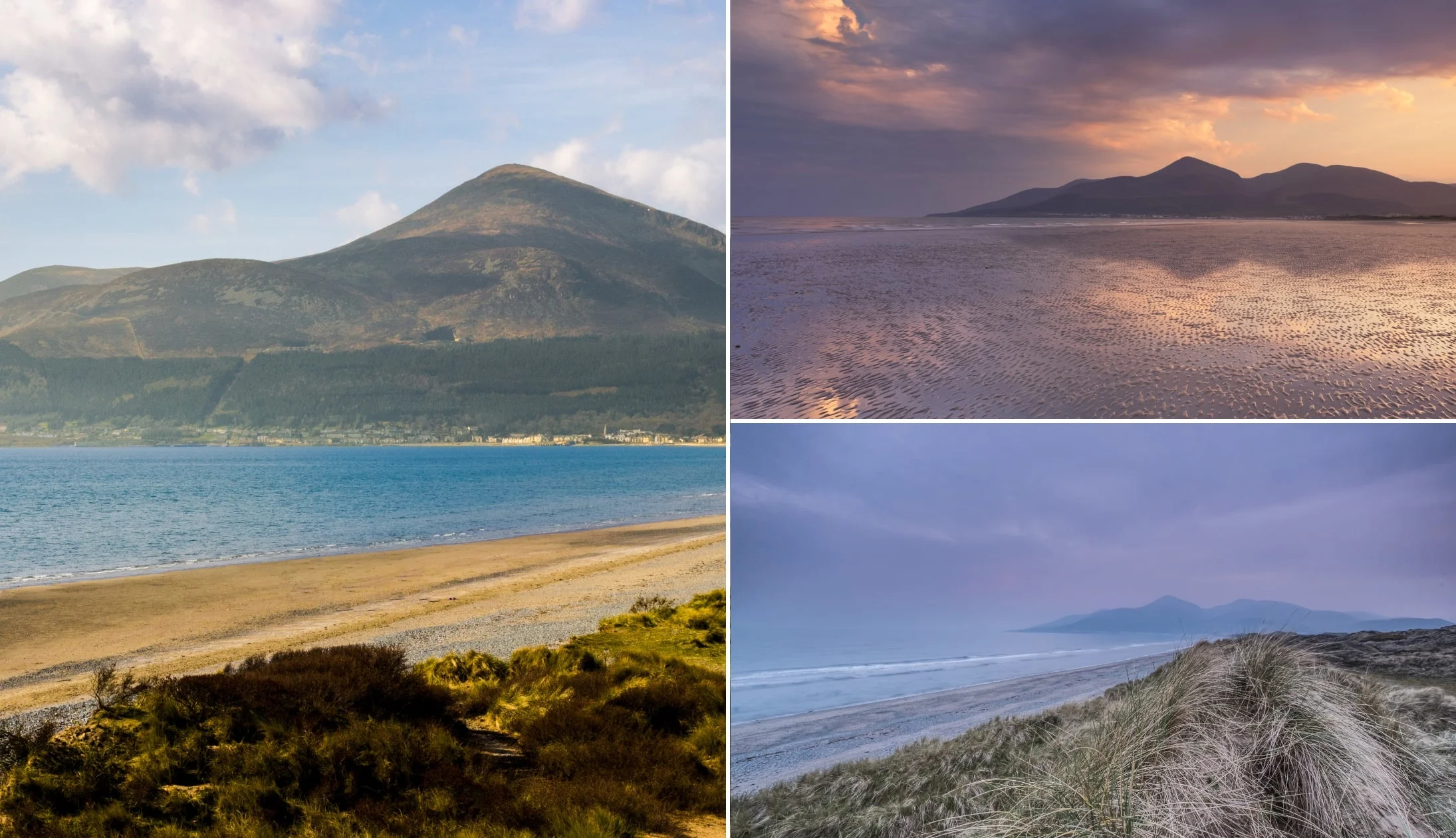
Photos via Shutterstock
Newcastle Beach is the ideal place to relax while you digest. A beautiful sandy beach with gorgeous views in every direction, it’s perfect for sitting back and contemplating life. You’ll also find a lovely promenade that you can stroll along. The beach is just behind the main street in Newcastle, so it’s easy enough to walk there after lunch.
Stop 5: Tollymore Forest Park

Photos via Shutterstock
Just a 10-minute drive from Newcastle, you’ll find our next stop for the day, Tollymore Forest Park. This is an incredible area of natural beauty that could easily fit into a fantasy novel—in fact, some scenes from Game of Thrones were filmed here too.
You can enjoy a few long walking trails through the hauntingly beautiful forest if you’ve still got some energy left, or take it easy on some of the shorter routes. Either way, you’ll take in rivers, towering trees, quaint bridges, and mystical clearings as you amble along.
Stop 6: Back to Belfast for the Evening

Photo left: Silvia Franceschetti (CC BY-SA 3.0). Others via Bittle’s Bar on FB
Once you’ve finished exploring the magical forest, it’s time to head back to Belfast. This will be your last night in the city for a while, so make sure to check out anything you’ve missed so far. It should take just under an hour to reach the city and your accommodation.
You’ll find tons of options for food, drink, entertainment, and plenty of live music here, so whether you go back to your accommodation to freshen up first or head straight out is up to you.
Our Belfast food recommendations
There’s some outstanding restaurants in Belfast City. First up, Deanes is a Belfast institution and a must-visit while you’re in the city. There are three venues to choose from, each focusing on something different; Deanes Meat Locker, Deanes Love Fish, and Deanes at Queens.
Whichever you choose, you’re in for a fine feed. EDO is another favourite of ours, a stunning tapas and cocktail bar with incredible sharing platters.
Or, for a fancy meal, head to The Ginger Bistro, near the Belfast Opera House. Their menu is out of this world, though that’s no surprise when you consider it was voted the best restaurant in Northern Ireland.
Our Belfast pub recommendations
There are countless incredible pubs and bars in Belfast for a tasty after-dinner tipple. Check out traditional options like the unmistakable Bittles Bar, with its stunning range of local beer and Irish whisky.
The Duke of York is another old-school boozer, walls adorned with knick-knacks from yesteryear and serving up a fine pint of Guinness.
Finally, we couldn’t forget Madden’s Bar, a cosy, traditional pub complete with a roaring wood-burning stove and a friendly atmosphere. Somewhat overlooked, it’s a hidden gem, beloved by those in the know!
Traditional musicians from across Ireland come to play at Kelly’s Cellars every Tuesday, Wednesday, Thursday, and Saturday.
Other fantastic options for music include Fibber Magees, another charmingly old-fashioned pub with a lively atmosphere, and the John Hewitt.
Day 4: Derry — City and Coast
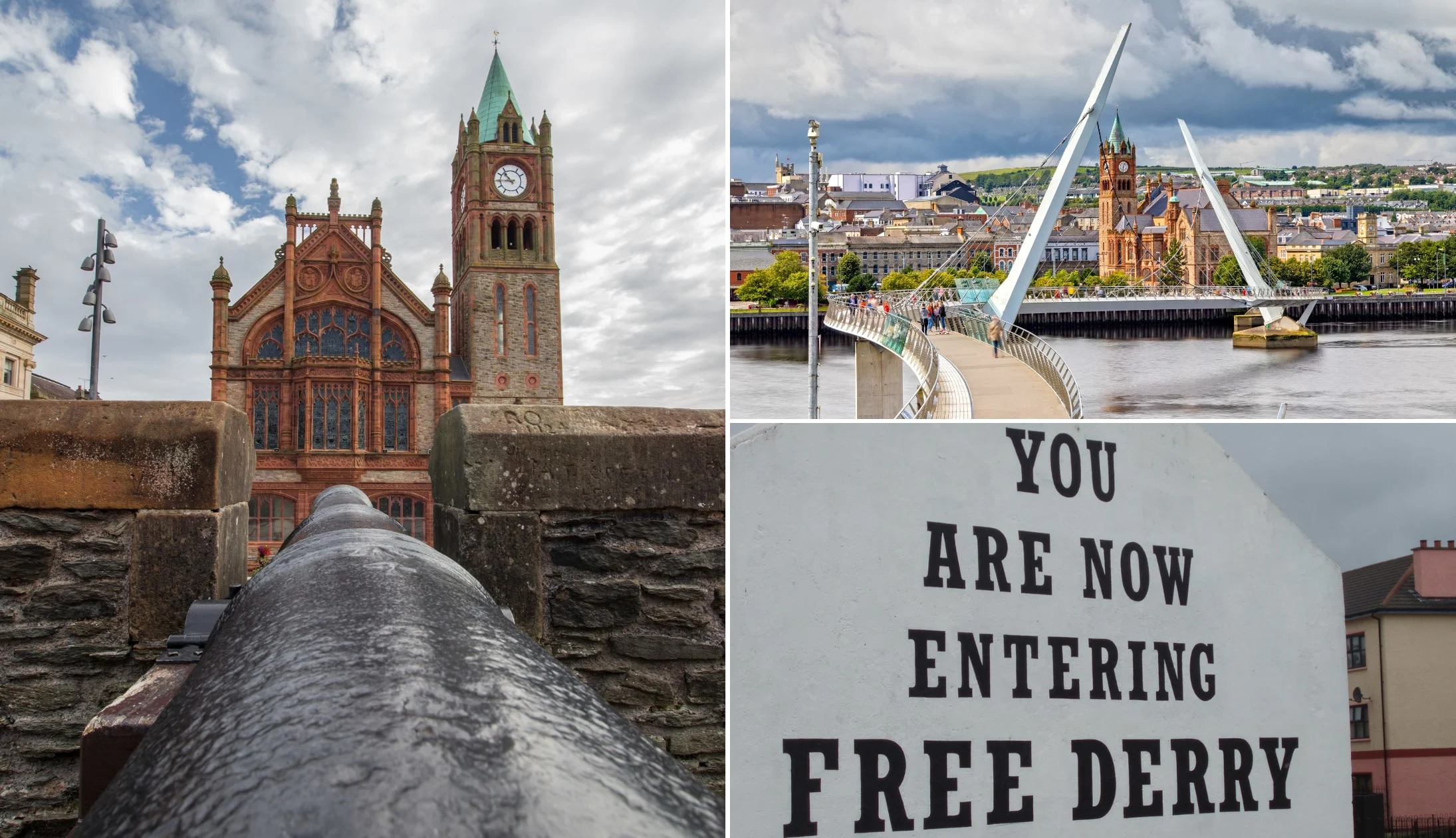
Photos via Shutterstock
Today we head to Derry, where we’ll be staying for two nights. The walled city of Derry is a historic and cultural gem that is absolutely bursting with things to see and do.
This will be your last breakfast in Belfast for a little bit, so make it a good one! Harlem Café is a top spot, serving up a sumptuous full Irish and a smorgasbord of alternatives, including plenty of veggie and vegan options.
Once you’ve filled up, it’s time to say goodbye to Belfast for now and hit the road to Derry (make sure you’ve your accommodation booked in advance).
Our Derry accommodation recommendations
- Budget: Rose Park House (cosy, great reviews and a 20-minute walk from the centre) and Bishop Gate BnB (excellent reviews and a 10-minute walk from the city centre)
- Mid-range: Number 8 The Townhouse and Shipquay Boutique Hotel (both very central with top reviews)
- Luxury: Bishop’s Gate Hotel (gorgeous and central luxury accommodation)
Stop 1: Mussenden Temple

Photos via Shutterstock
After leaving Belfast, you’ll drive for about an hour and fifteen minutes through the gorgeous Northern Ireland countryside before reaching our first stop, Mussenden Temple. Inspired by Italy’s Temple of Vesta, this former estate library dates back to 1785. It perches on the edge of the cliffs, 120 feet above the sea below, in Downhill Demesne.
The temple is absolutely stunning to look at both up close and from afar. There’s a handy car park, which costs £5 for non-National Trust members, and from there, you can enjoy a beautiful little coastal walk. Along the way, you’ll pass ruins and soak up incredible views out to sea.
Stop 2: Benone Strand
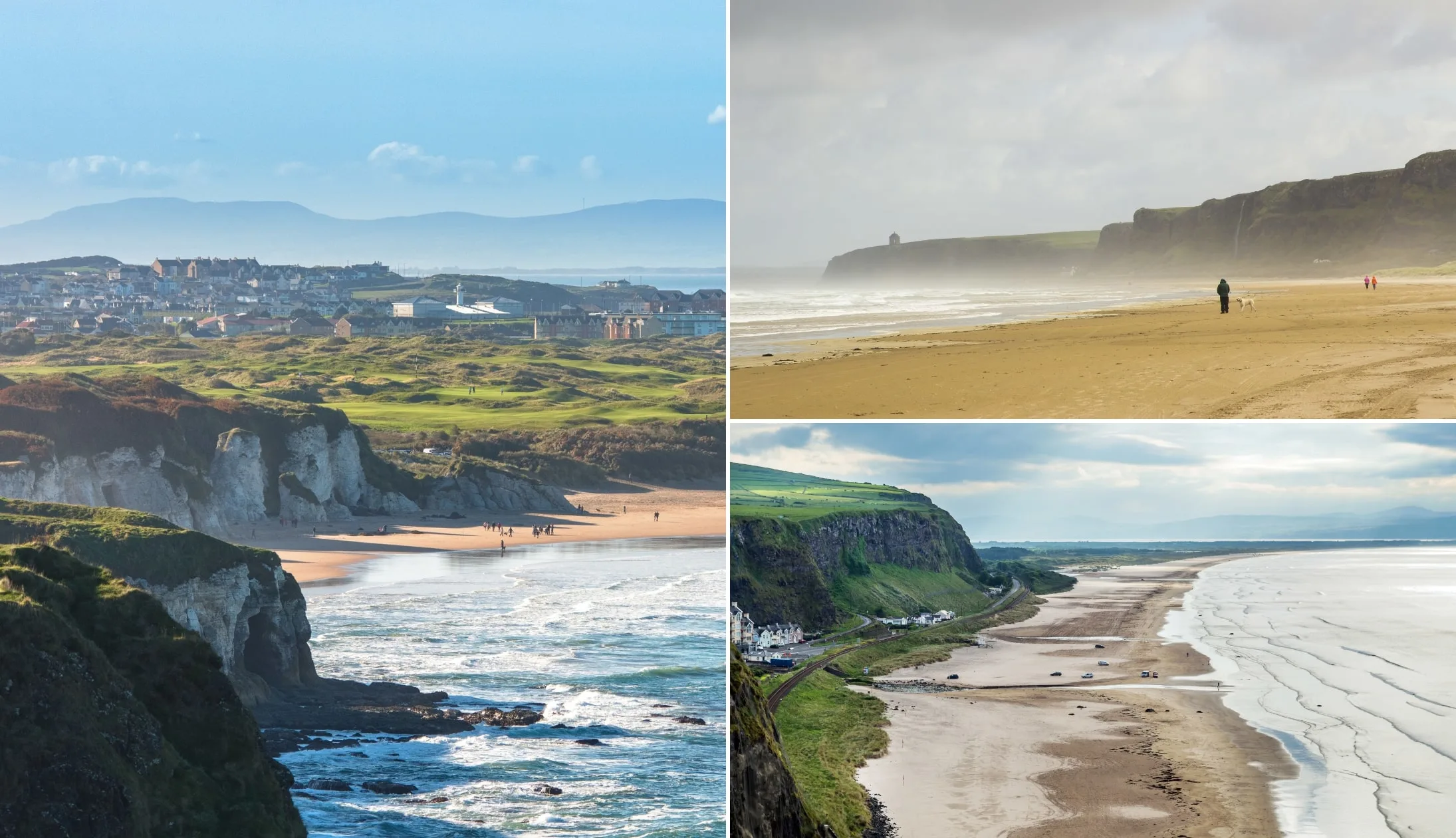
Photos via Shutterstock
Benone Strand is our next stop, and it’s just a 6-minute drive from Mussenden Temple. This is a lovely, almost 15 km long sandy beach that is ideal for strolling along and enjoying the sound of the waves and the salty sea air. You can pretty much park directly on the beach itself, then spend as long as you like walking among the sand dunes. Head east, and you’ll come across gorgeous green cliffs and Dunne Waterfall if you go far enough.
Benone Strand is also a popular spot for water activities like surfing and swimming. You can normally rent a wetsuit and board from the Sea Shed if you’re that way inclined, where they also have toilets and showers.
Stop 3: Binevenagh Loop
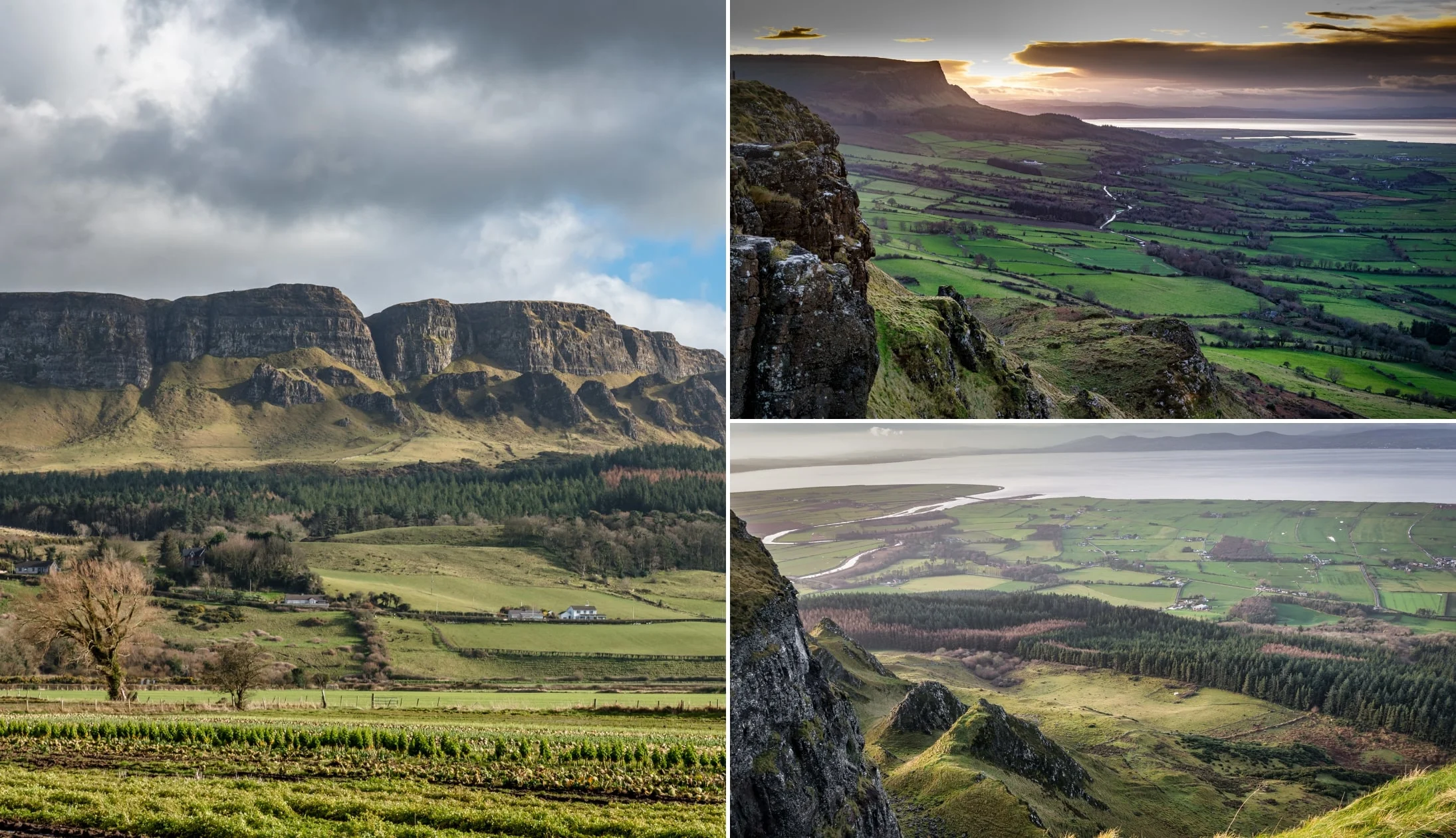
Photos via Shutterstock
Our next stop is a moderately challenging 5 km looped walk through the spectacular Binevenagh Area of Natural Beauty. It’s about a 15-minute drive from Benone Strand, just before the town of Limavady, and offers up some amazing views along the way. While the trail isn’t particularly well-signed, the path is well-trodden and easy enough to follow. You’ll climb about 225 metres in total, taking in lakes, pine forests, and grassy fields.
The views along the entire route are breathtaking, but the best are from the summit. When you make it, you can see for miles all around and across the sea. On average, it should take about an hour and forty minutes to complete the loop, and it’s well worth the effort.
Stop 4: Derry

Photos via Shutterstock
Next stop, Derry City! It’ll be about a 40-minute drive from Binveagh. If it’s too early to check into your accommodation, you can park up in the Bishop’s Street Car Park while you look around and grab lunch. This handy, centrally located car park is ideal for exploring the city on foot. Plus, it’s very cheap, I think around 60 pence an hour or so.
Stop 5: Lunch
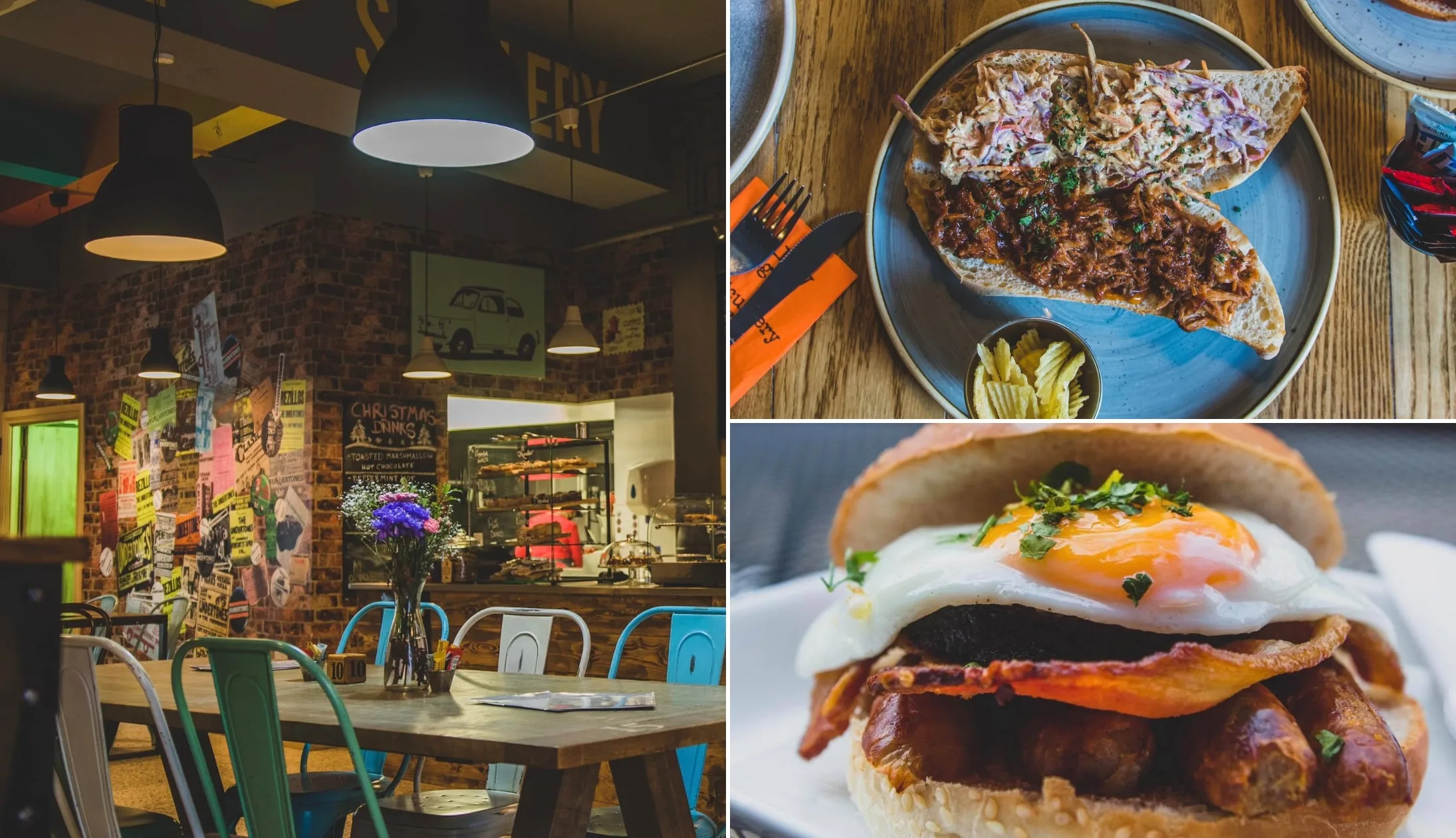
Photos via Scullery Cafe on FB
You should arrive in Derry just in time for lunch. You’ll find tons of great spots in the city centre. The restaurant at the Shipquay Hotel is a superb choice, with a fantastic lunch menu that has light options like sandwiches alongside fish and chips, steaks, and veggie and vegan options. Plus, it’s just a 6-minute walk from the car park.
The Pickled Duck Cafe is another great choice, just a little further up the road. It enjoys a superb location opposite the Guild Hall and a laid-back, no-nonsense menu of tasty dishes to suit all dietary needs. Finally, the Scullery Cafe is a top choice for coffee lovers and they also serve up a great selection of soups, sandwiches, wraps, and more.
Stop 6: The Walls of Derry

Photos via Shutterstock
Derry is the only fully walled city in Ireland and one of the best examples of a European walled city on earth. Dating back to the early 17th century, the walls circle the original city, standing an impressive 20 feet high. No visit to Derry would be complete without scaling the walls and admiring the view as you walk around the mile-long oval.
Head to Bishop’s Gate and start your walk there. As you go, you’ll pass numerous watch towers, 6 more gates, and a bunch of mighty cannons.
Stop 7: Free Derry Corner
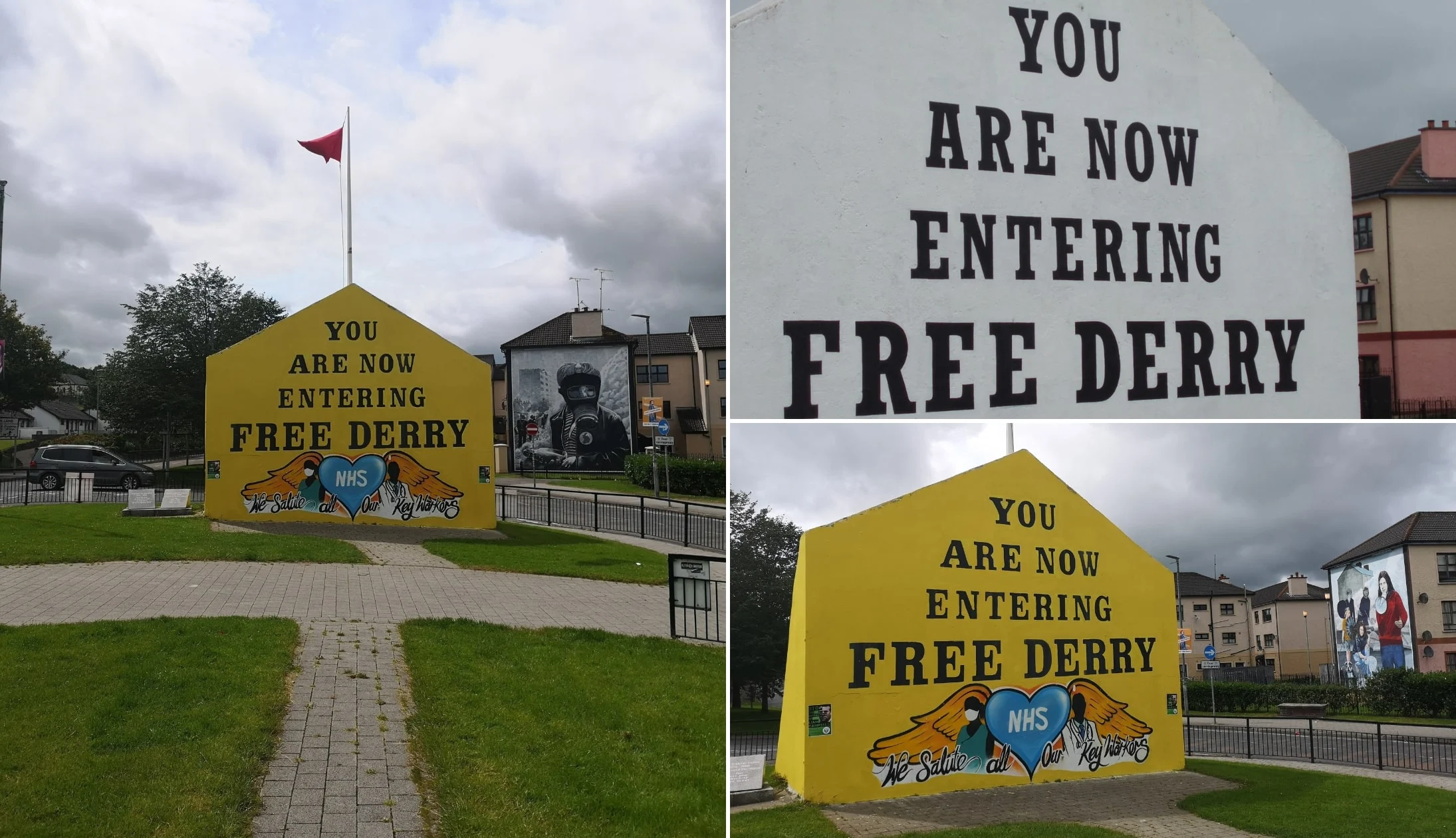
Left and bottom right photo: The Irish Road Trip. Top Right: Shutterstock
Once you’ve come down from the city walls at Bishops Gate, you’re just a 6-minute walk from the iconic Free Derry Corner. Located in the Bogside neighbourhood of Derry, this modern landmark sits on the site where the Battle of Bogside and Bloody Sunday massacre took place. Originally painted in 1969, it’s a hugely important area.
For a more in-depth explanation of the significance of Free Derry Corner, it’s well worth joining a guided Bogside History Tour.
Stop 8: Coffee and the Peace Bridge
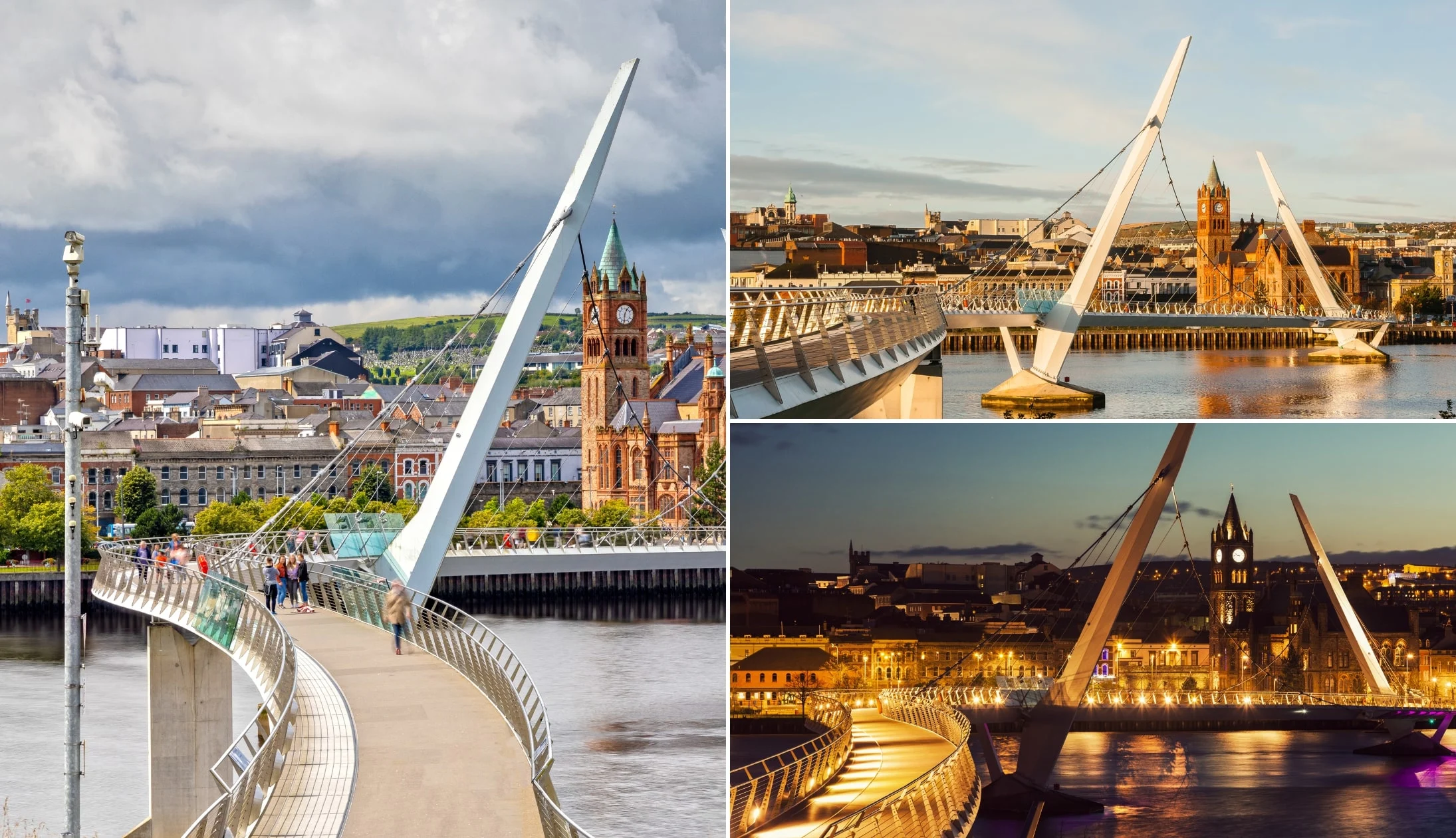
Photos via Shutterstock
Next, you’ll want to make your way towards the River Foyle, passing back through the old town. If you fancy a coffee along the way, both Cappuccinos and the Coffee Pot make a great cup, as well as a good selection of cakes and pastries. Take your coffee to go, then head round the corner to the Peace Bridge.
This pedestrian bridge weaves across the river. Made from two identical halves that meet in the middle to form a metaphorical handshake, it was built to bring the east and west sides of Derry closer together, breaking a 400-year animosity between the two sides.
If you’re a fan of “Derry Girls”, there’s a superb mural on the back wall of Badger’s Bar. You can take a slight detour on your way to the Peace Bridge to check it out or drop by after checking out the bridge.
Stop 9: Dinner, drinks and live music
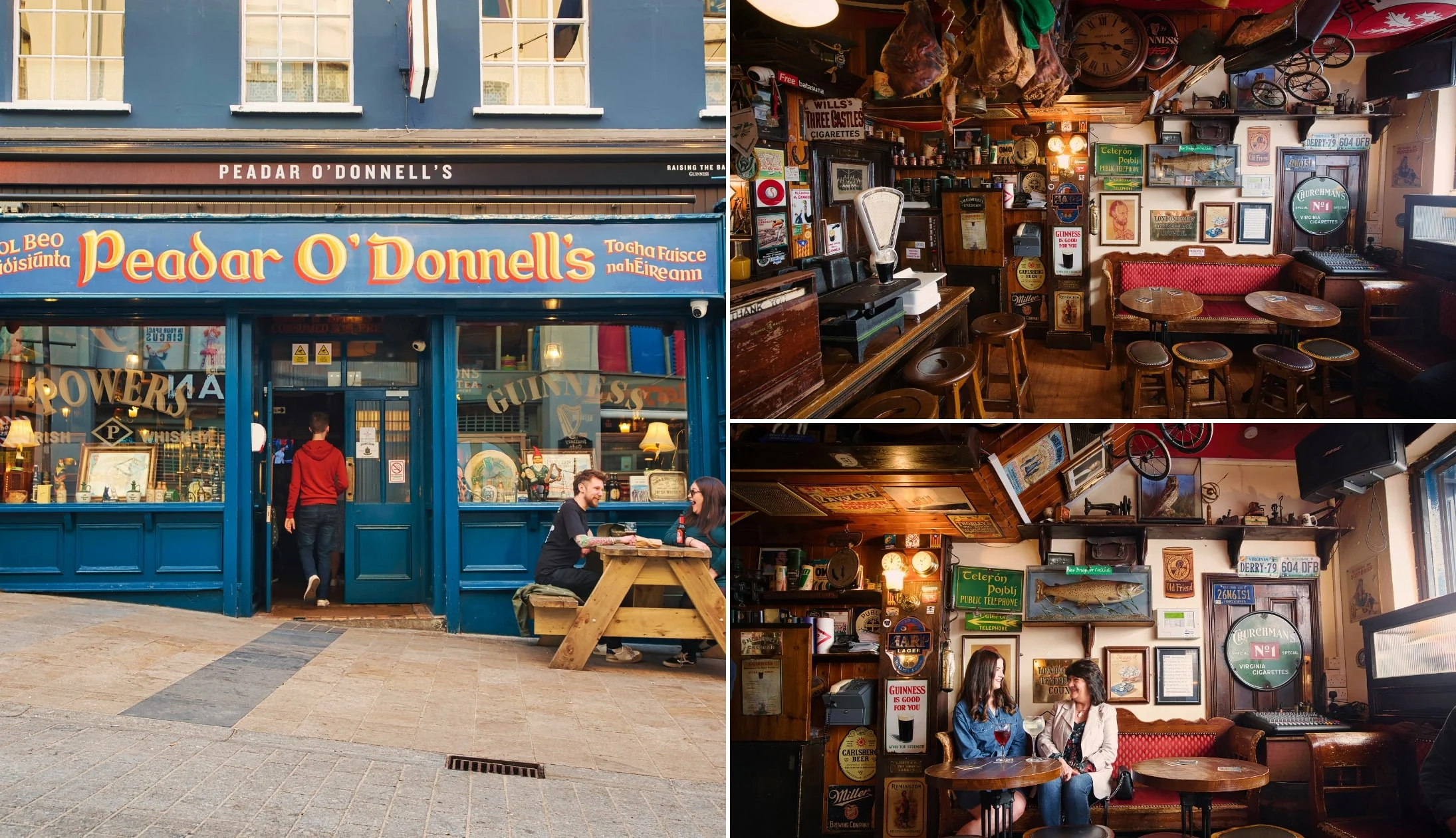
Photos courtesy of Tourism Northern Ireland
Now that you’ve seen the main sights and attractions in Derry City, it’s time to hit the town and enjoy some dinner, drinks, and live music.
Check into your accommodation, freshen up, and then enjoy these incredible places to check out.
Our Derry food recommendations
There’s no shortage of great places to eat out in Derry. If you didn’t check out Ship’s Quay for lunch, it’s also a good choice for dinner, with a larger, more varied menu.
If you’re up for a little fine dining, Browns Bonds Hill is a good choice, with a seasonal menu of beautifully cooked and presented dishes.
For a more laid-back feed, drop by Badgers Bar and Restaurant (check out the Derry Girls Mural on the back wall if you haven’t already!).
Our Derry pub recommendations
Whenever we’re in Derry, we try to drop by Walled City Brewery. It’s a fantastic little brewpub that offers a range of gorgeous beers, mostly brewed on-site.
For a more traditional pub experience, get down to Blackbird, where you’ll find retro decor and a superb gin and whisky selection, as well as cocktails, craft beers, and much more.
Grand Central Bar is another good choice, a cosy little old-school bar with excellent Guinness and regular impromptu trad sessions.
First of all, check out the Dungloe Bar, considered by many to be the best in the city for music. Peader O’Donnel’s is also worth a shot, a quirky and lively bar with live music every Saturday. Right next door, you’ll find The Gweedore Bar, which also does excellent live music on the weekends.
Day 5: Derry and Donegal
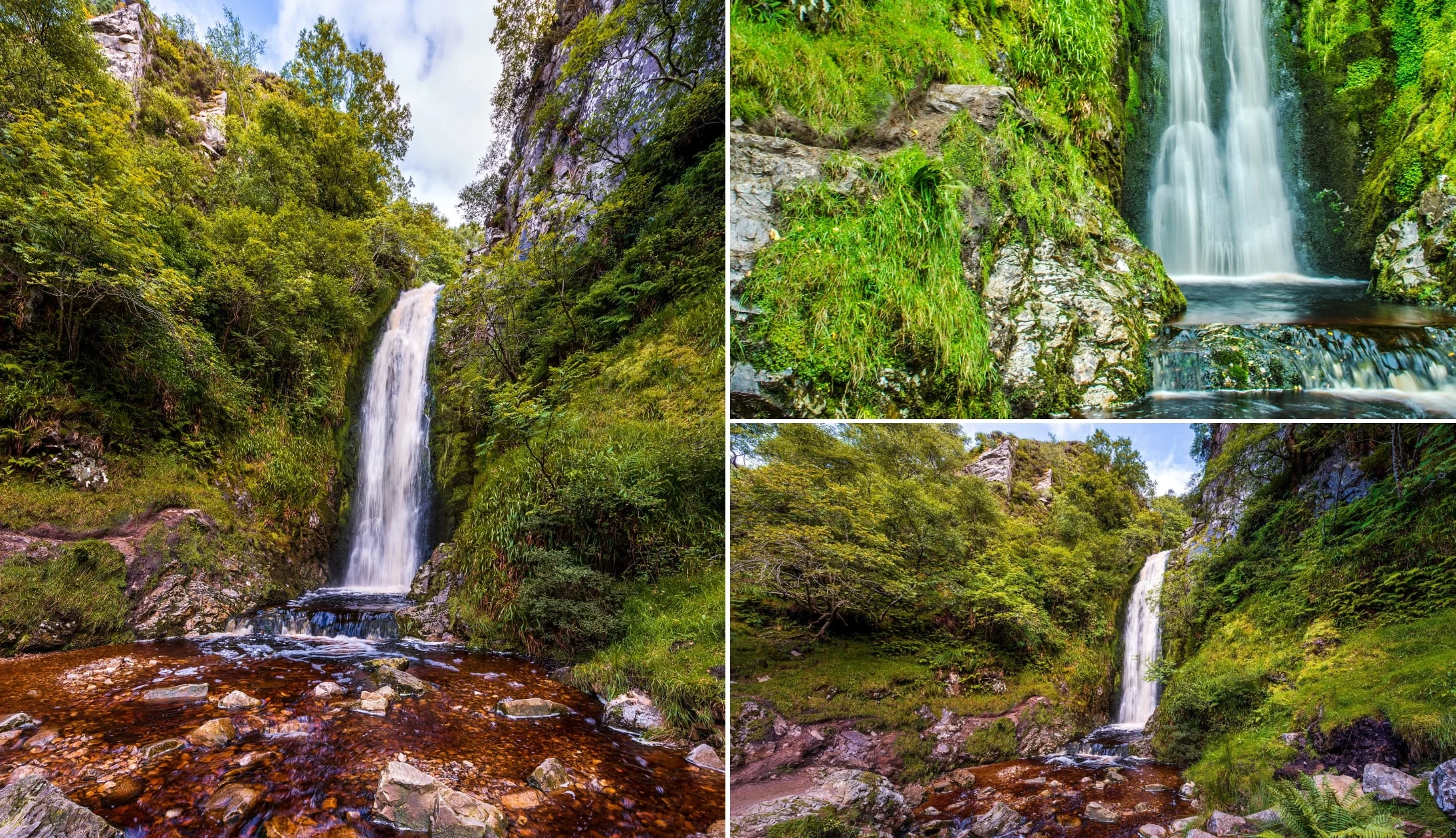
Photo left and bottom right: Gareth Wray. Top right: Shutterstock
Today we’ll be hopping over the border into the Republic of Ireland as we explore the stunning Inishowen Peninsula.
The drive today, known as the Inishowen 100, will take you all the way to Ireland’s most northerly point, taking in a clatter of superb attractions along the way.
Once you’ve seen everything, you’ll take a gorgeously scenic road back to Derry for your final night in the town.
Let’s start the day right with a slap-up breakfast. Most places you’ll stay offer a good breakfast, but if you prefer to eat out, check out the Scullery Cafe in the town centre for a fabulous Full Irish.
Hidden City Cafe is another top choice, and while they also offer a great fry-up, you’ll find several lighter options too.
Stop 1: Greenan Mountain or Grianan of Aileach
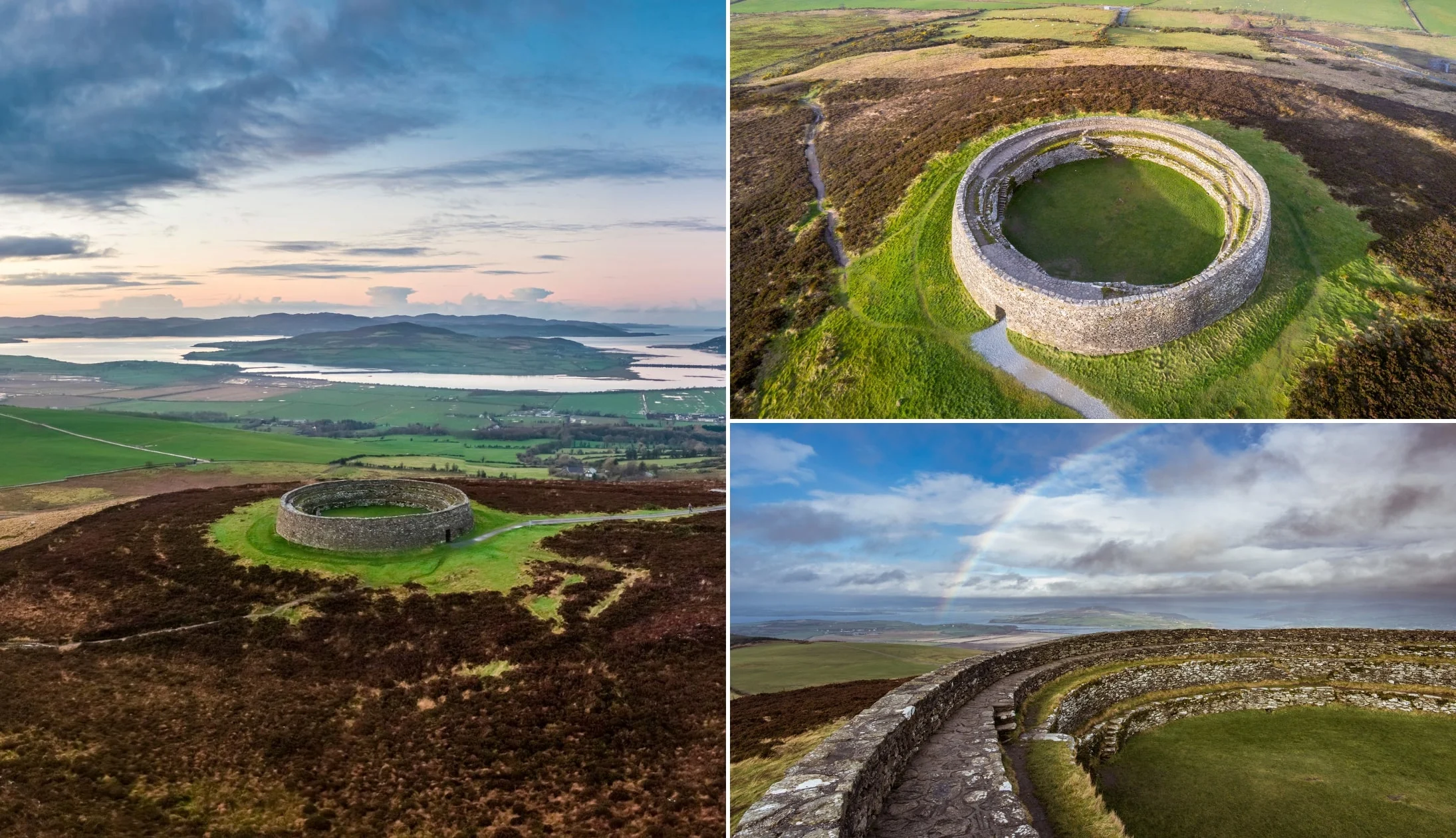
Photos via Shutterstock
Our first stop of the day is Greenan Mountain, otherwise known as Grianan of Aileach or An Grianan Fort. It’s just 22 minutes outside of Derry, and there’s a small but handy car park at the top of the hill. From there, it’s just a short, though somewhat challenging, walk to one of the most impressive Hill Forts in Ireland.
Dating back to 1700 BC, the fort is steeped in history and myth. It’s free to enter and offers stunning views of the surrounding landscape, which takes in Lough Foyle and Lough Swilly, as well as Inch Island, a favourite among photographers.
It gets pretty wild and windy up there, so be sure to dress suitably! By the way, welcome to the Republic of Ireland!
Stop 2: Buncrana Beach
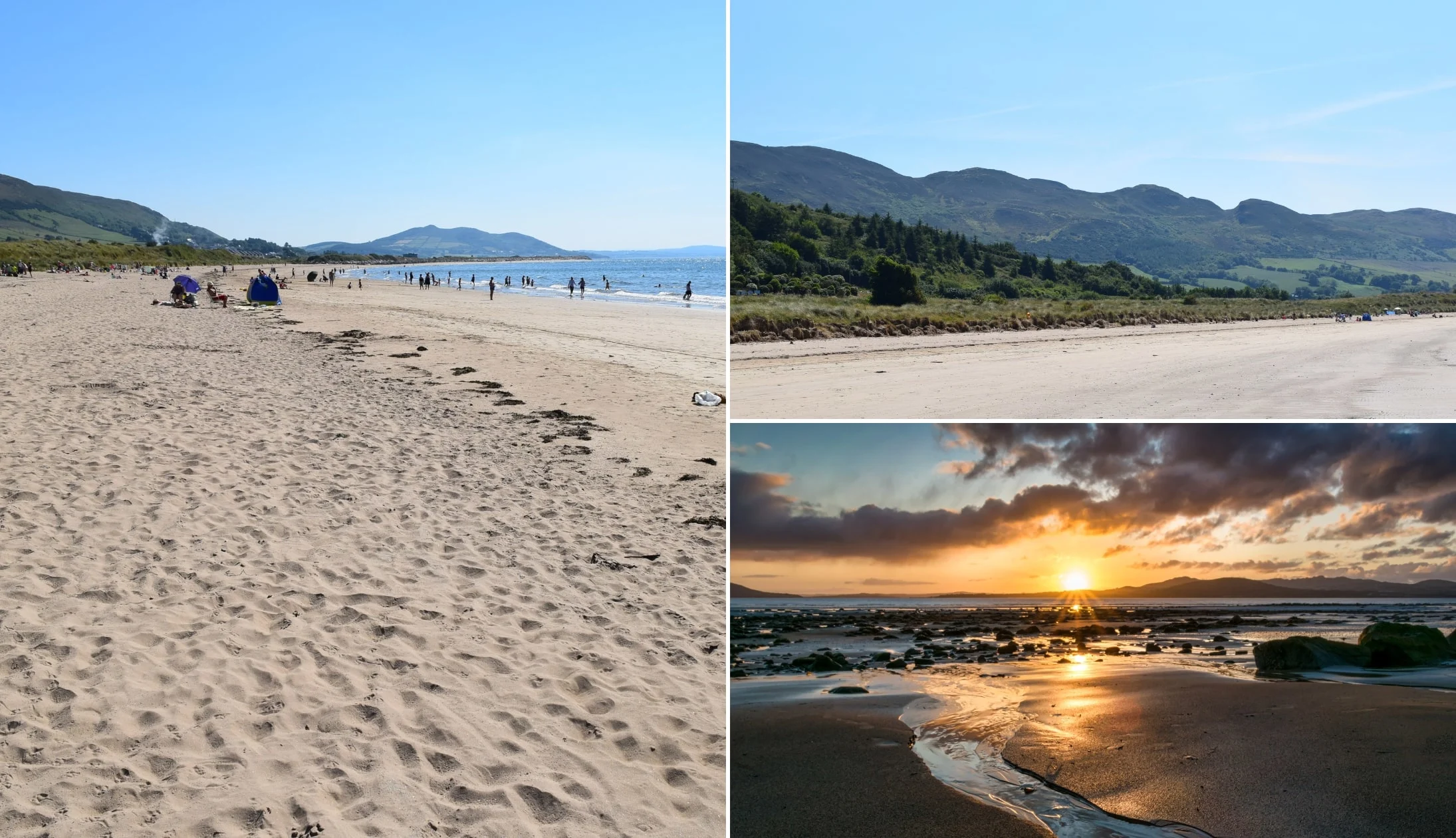
Photos via Shutterstock
After a nice bumble on Greenan Mountain, our next stop is the wonderful Buncrana Beach. Well, there are actually several beautiful beaches here, situated on the shores of Lough Swilly. The main Buncrana Beach boasts a long sandy expanse, ideal for a nice stroll amid some stunning scenery. It’s about a 19-minute drive from Greenan Mountain.
Stop 3: Fort Dunree

Photos via Shutterstock
Our next stop takes us to Fort Dunree, about an 18-minute drive away from Buncrana Beach. Perched on the western edge of the Inishowen Peninsula, it was built in the early 1800s to protect the entrance into Lough Swilly during the Napoleonic wars. It’s a fascinating place to explore, complete with Ireland’s first funicular railway, a glass walkway, and a military museum.
Stop 4: Glenevin Waterfall

Photo left and bottom right: Gareth Wray. Top right: Shutterstock
After exploring Fort Dunree, we’ll drive another 20 minutes to Glenevin Waterfall. This gorgeous 40-foot cascade is a hidden gem in the Donegal countryside, and there’s a superb walk through beautiful scenery to get to it. You can park in a small car park just off the main road in Clonmany and from there, it’s easy enough to follow the well-marked Waterfall Walk trail. It’ll typically take an hour or so to complete the walk both ways.
Stop 5: Doagh Famine Village
Our next stop is the Doagh Famine Village, a unique attraction that offers a fascinating look back at over 200 years’ worth of Irish history. With gorgeous thatched cottages and a variety of displays and exhibits, you’ll find plenty to look at. The village gives an insight into how life was lived in this remote corner of Ireland for hundreds of years. At times harrowing, it’s an emotional journey that’ll teach you more about Irish history and customs in its 40-minute tour than any amount of reading online.
The village is just a 14-minute drive from Glenevin Waterfall. It’s worth noting, however, that it’s only open between mid-March and mid-October.
Stop 6: Lunch

Photos via The Butterbean Restaurant on FB
It’s been a fairly action-packed morning, so you’ll be more than ready for a bite to eat. Drive the 16-minute road to the bustling village of Carndonagh, where you’ll find plenty of fantastic options. The Butterbean is one of our top picks, and they offer a varied menu of Irish classics, sumptuous burgers, and seafood.
For something a little lighter, you can grab a tasty bowl of soup and a sandwich at Diamond Cafe, which also does a range of cakes, baps, and much more. Harkins is another top choice for a cafe lunch.
Stop 7: Malin Head

Photos via Shutterstock
After a good feed, it’s time to head north to Malin Head. In fact, you can’t get any further north than this, the most northerly point on the island of Ireland. From Carndonagh, it’s about a 25-minute drive and you’ll find a decent little car park, complete with toilets, and a little way up the road, the Cafe Banba coffee van.
The best way to explore Malin Head is to do the Malin Head Walk, a moderate hour-long stroll that takes in all the main points of interest. It’s just under a kilometre long in total and starts off at the car park. From there, you’ll take in Lloyds Signal Tower, the EIRE 80 sign, and the epic Hells Hole, as well as catching an eyeful of gorgeous natural beauty. When you’re done, it’s worth dropping into Farren’s Bar for refreshments.
Stop 8: Kinnagoe Bay
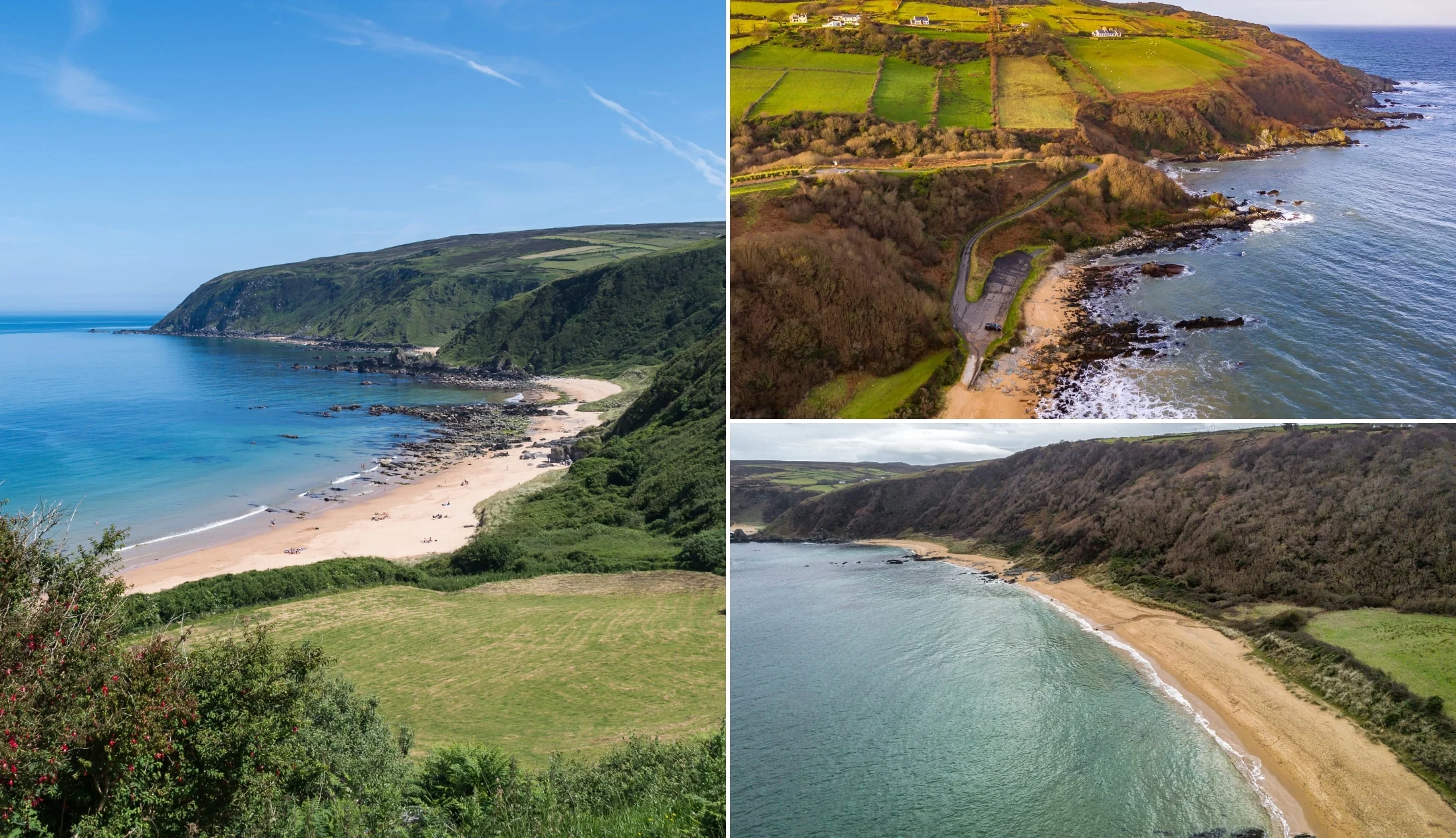
Photos via Shutterstock
Once you arrive at our next stop, you’d be forgiven for thinking you’d teleported to a tropical island in the Pacific Ocean. Kinnagoe Bay is one of Ireland’s hidden gems, a gorgeous sandy beach with stunningly clear waters. Surrounded by towering green cliffs, it’s picture-perfect. There’s a nice lookout point, but if you prefer to get close, you’ll find a small car park on the edge of the beach. Just beware, it’s down a very steep and narrow lane.
There are no lifeguards at Kinnagoe Bay, though it is a popular swimming spot for confident swimmers. The waters can be a little rough at times, so it’s probably best to just chill out on the sand and take in the views. It’s a 46-minute drive from Malin Head.
Stop 9: Inishowen Head Lighthouse
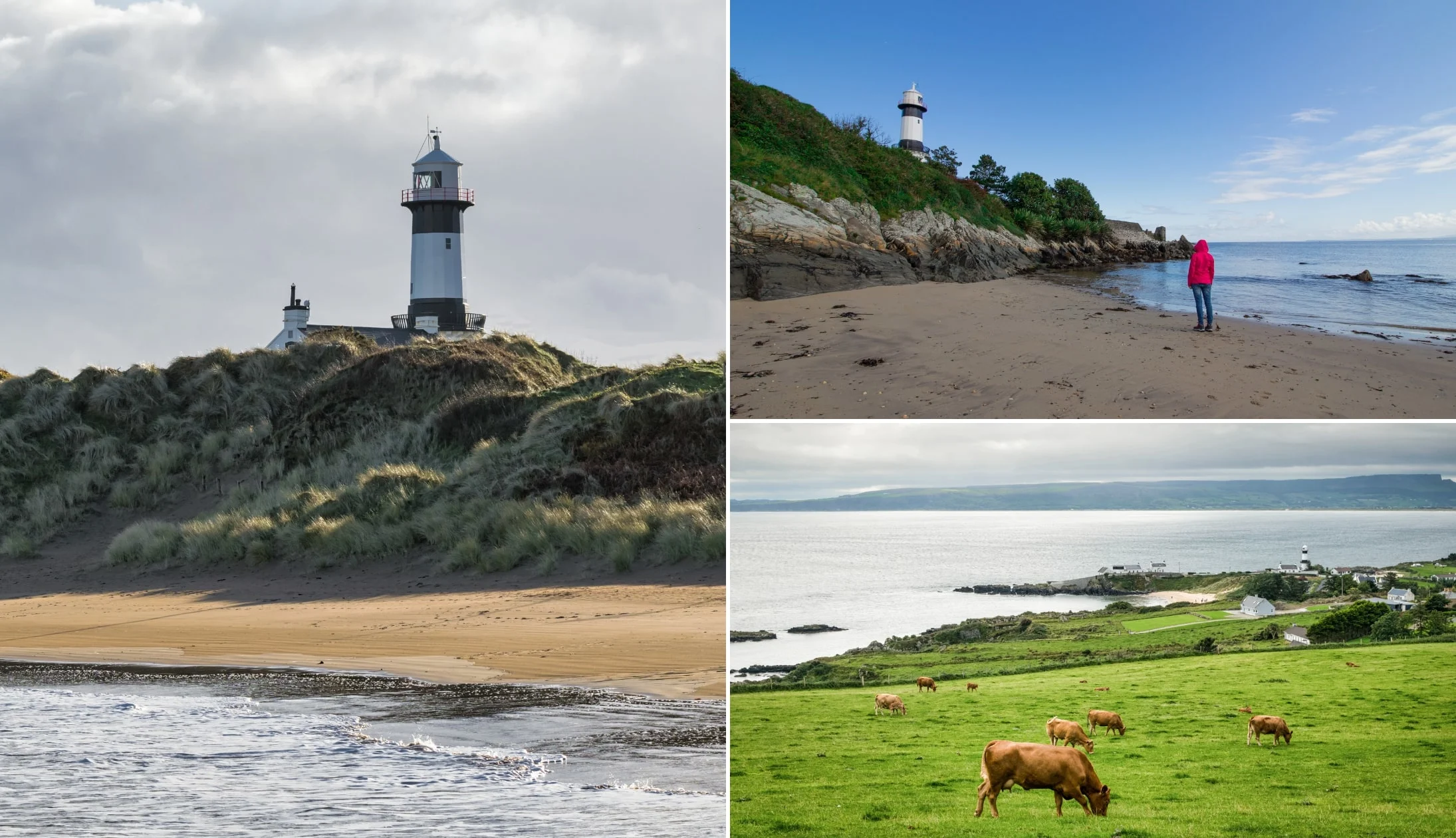
Photos via Shutterstock
As we head back toward Derry, there’s just one last little detour. Inishowen Head Lighthouse is a 16-minute drive from Kinnagoe Bay. It’s a gorgeous lighthouse, surrounded by breathtaking scenery, but it’s worth noting that you won’t find a visitor centre or tours of the inside here. Having said that, it’s a nice area to wander around and enjoy the views, and there’s even a small beach nearby.
Stop 10: Back to Derry for the night

Photos courtesy of Tourism Northern Ireland
It’s now time to head back to Derry for the night and you’re in for a treat. The road back hugs the coast on the southeastern edge of the Inishowen Peninsula, offering stunning scenery the entire way. It’ll take about 45 minutes to get back to Derry.
Now that you’ve seen the main sights and attractions in Derry City, it’s time to hit the town and enjoy some dinner, drinks, and live music.
Check into your accommodation, freshen up, and then enjoy these incredible places to check out.
Our Derry food recommendations
There’s no shortage of great places to eat out in Derry. If you didn’t check out Ship’s Quay for lunch, it’s also a good choice for dinner, with a larger, more varied menu.
If you’re up for a little fine dining, Browns Bonds Hill is a good choice, with a seasonal menu of beautifully cooked and presented dishes.
For a more laid-back feed, drop by Badgers Bar and Restaurant (check out the Derry Girls Mural on the back wall if you haven’t already!).
Our Derry pub recommendations
Whenever we’re in Derry, we try to drop by Walled City Brewery. It’s a fantastic little brewpub that offers a range of gorgeous beers, mostly brewed on-site.
For a more traditional pub experience, get down to Blackbird, where you’ll find retro decor and a superb gin and whisky selection, as well as cocktails, craft beers, and much more.
Grand Central Bar is another good choice, a cosy little old-school bar with excellent Guinness and regular impromptu trad sessions.
First of all, check out the Dungloe Bar, considered by many to be the best in the city for music. Peader O’Donnel’s is also worth a shot, a quirky and lively bar with live music every Saturday. Right next door, you’ll find The Gweedore Bar, which also does excellent live music on the weekends.
Day 6: The Trip to Dublin

Photos via Shutterstock
Next stop, Dublin City! We’ll be driving straight to the city from Derry in order to spend the rest of the day exploring Ireland’s vibrant capital city on foot.
Grab breakfast at your accommodation or nearby. When you’re ready, it’s time to hit the road!
You’ll be spending two nights in Dublin – make sure to book your accommodation in advance.
Recommended accommodation in Dublin
- Budget: Abigail’s Hostel (Temple Bar), Jacobs Inn (central hostel) and the Generator Hostel (short walk from city)
- Mid-range: Dublin Skylon Hotel (just outside the city), Wren Urban Nest (Temple Bar) and the Harding Hotel (very central)
- Luxury: The Merrion (St. Stephen’s Green – very central) and The Westin (just off Grafton Street)
Getting around Dublin + money savers
- Time savers: If you want to avoid walking where possible, it’s worth getting a ticket for the Hop On Hop Off Bus around Dublin. It goes to or near all of the main sites on this itinerary plus plenty more.
- Money saver: If you’re visiting the ‘main’ Dublin attractions, the Dublin Pass can save you €€€ (here’s how)
Stop 1: Dublin City

Photos via Shutterstock
We’ll be starting the day with a fairly long, 3.5-hour drive straight from Derry to Dublin.
Once you arrive in Dublin, head to your accommodation to check in and park up, as we’ll be on foot for the rest of the day.
Stop 2: Park up and then head to Trinity College

Photos via Shutterstock
Head straight to wherever you’re staying. Check in and leave the car behind you. The city is very walkable.
When you get to the city, head straight for Trinity College to see the Book of Kells, arguably the most famous cultural attraction in Dublin.
If you can, we highly recommend pre-booking your tickets online, as the queues can get really long (bordering on ridiculous!). This fast-track ticket allows you to dodge the queue and gets you into Dublin Castle, too!
Spend around one hour seeing the Book of Kells, walking around the exhibit, and taking in the beauty of the Old Library. After that, give yourself another 20 minutes or so to walk around the university campus.
Stop 3: Lunch

Photos © Tourism Ireland
There’s plenty of great restaurants in Dublin, but for lunch we suggest you head to Neary’s. It’s just up the road from Trinity College, along the bustling Grafton Street.
This old-school pub is a classic and it serves up a range of simple lunch options, like sandwiches, soup, toasties, and Carlingford Oysters, all washed down with a tasty pint of Guinness.
Affordable and delicious, we can’t recommend it highly enough. Sprout and Co on Dawson Street is another good shout for a quick, light lunch that tastes great and is close to Trinity College.
Stop 4: The Ha’penny Bridge (via Temple Bar)
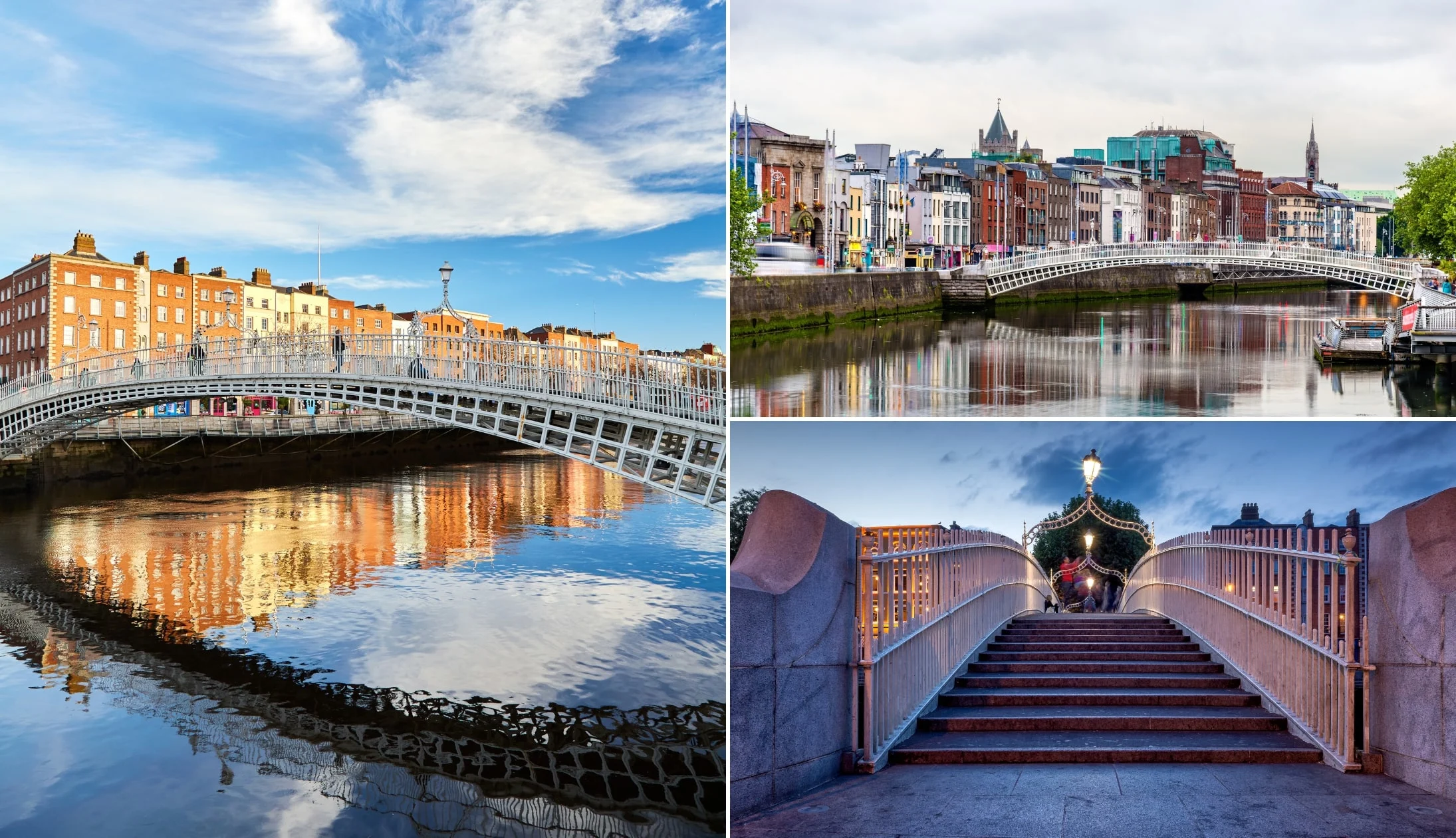
Photos via Shutterstock
The Ha’penny Bridge is an iconic sight in Dublin and crossing it is a must. From Neary’s, it’s about a ten-minute walk that passes through the vibrant Temple Bar area.
As you pass through Temple Bar, you’ll see why this is the nightlife capital of Dublin, with endless pubs and clubs lining the streets.
The bridge itself is a quaint little footbridge over the River Liffey. In the old days, you’d have to pay a toll of half a penny to cross, hence the name.
If you fancy a coffee after your walk, head to Vice Coffee Inc, just over the bridge for a superb brew. You’ll also find tons of shops and pubs to enjoy on either side of the bridge.
Stop 5: Dublin Castle
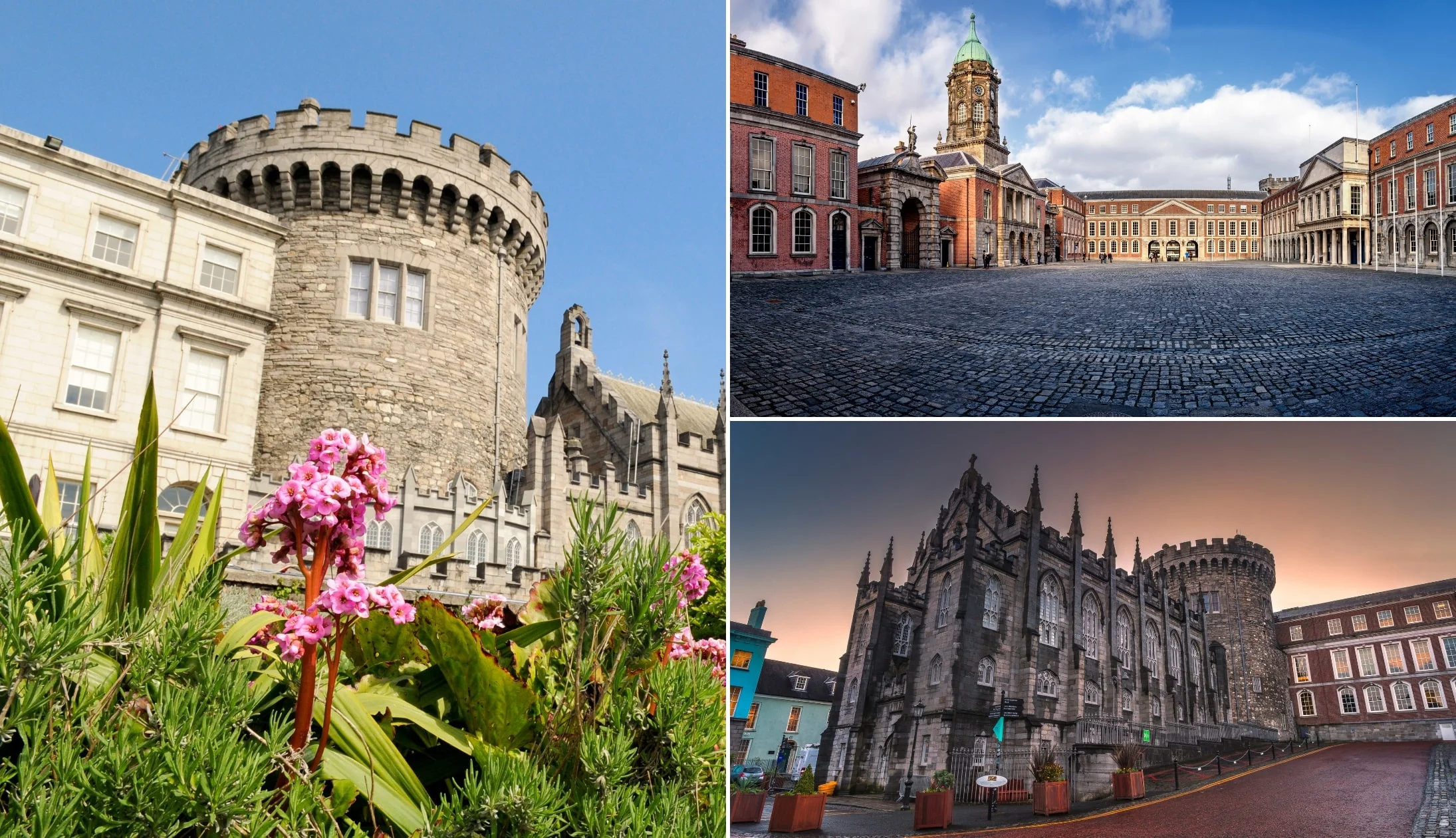
Photos via Shutterstock
Dublin Castle is a 10-minute walk from the Ha’penny Bridge. Dating back to 1204, it was for many years the Seat of British Power in Ireland until it was ceremoniously handed over to Michael Collins and his Provisional Government. Nowadays, it remains an important government building that hosts the inauguration of each President of Ireland and also various State receptions.
It’s well worth a visit, if only to take in the iconic architecture. However, we’d firmly recommend the guided tour as well. On the tour, you’ll hear the experienced guides tell countless tales about everything from underground chambers to Mediaeval towers. You’ll also hear fascinating eyewitness accounts from the 1916 Easter Rising and see all the spots associated with it.
Be sure to check out the subterranean chamber, as well as the gardens during your visit, and don’t forget the impressive Medieval Tower.
Stop 6: Christ Church Cathedral
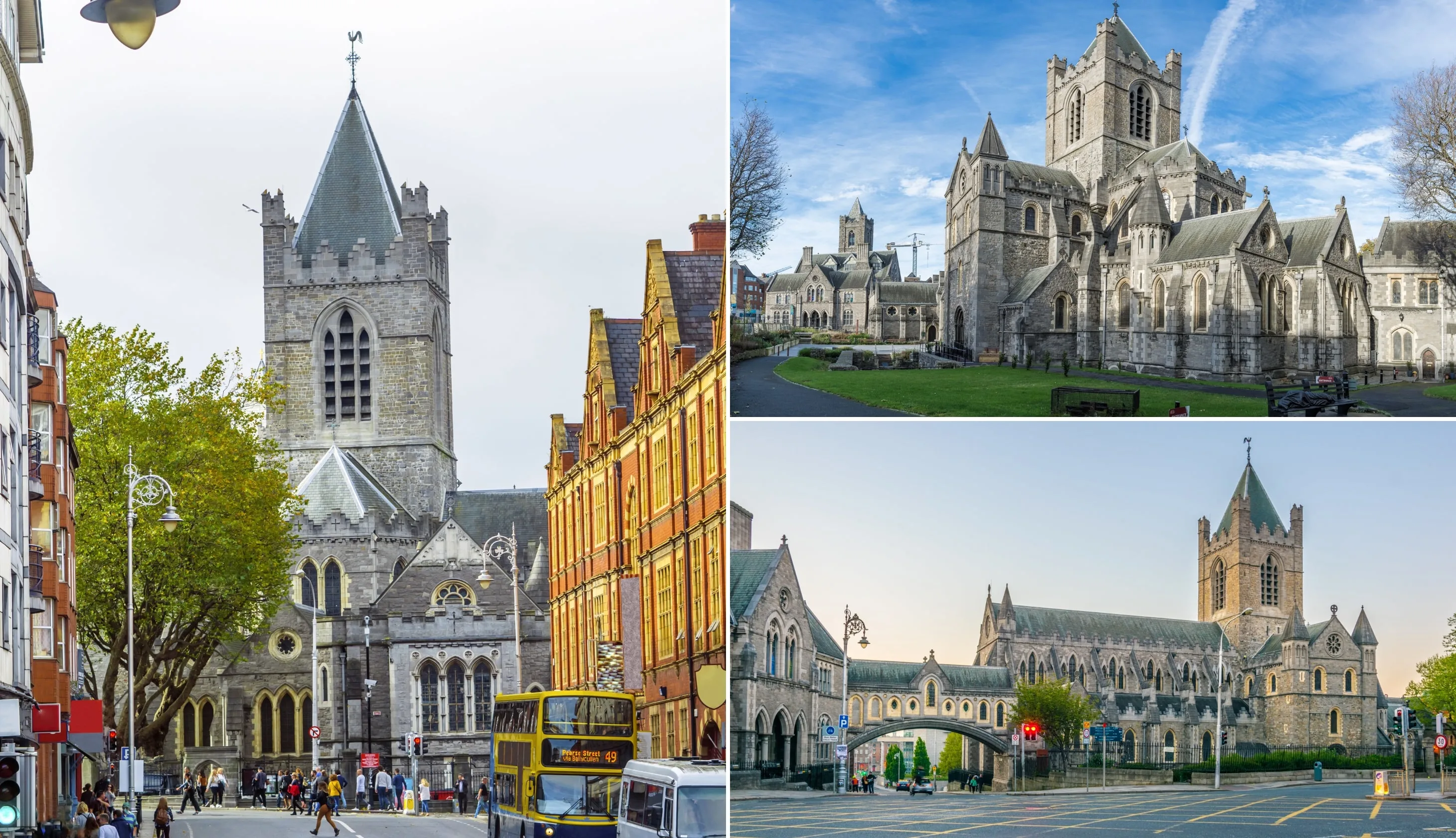
Photos via Shutterstock
Christ Church Cathedral (a 6-minute stroll from the castle) is another of Dublin’s top attractions and dating back more than 1,000 years, it’s pretty much as old as the city itself!
Steeped in history, it was originally founded by Viking king Sitruic Silkenbeard, but it’s come a long way since those early days (you can grab a ticket online here).
After admiring the stunning architecture from the outside, you can take a self-guided audio tour inside the cathedral.
Along the way, you’ll discover Strongbow’s grave and explore the crypts, which are home to a wealth of artefacts and exhibits, with such treasures as the mummified cat chasing a mummified rat inside an organ pipe.
Listen out for the record-breaking bells of Christ Church, and if you’re really lucky, you might catch the choir in action.
Stop 7: Guinness Storehouse

Photos © Diageo via Ireland’s Content Pool
Next up is another iconic Dublin attraction, the Guinness Storehouse, a 15-minute walk from Christ Church. Dublin is the home of Guinness, and this tour of the brewery is a must for anyone with a love for the black stuff.
In fact, even if you’re not a fan of beer, this is a fantastic attraction to visit. Book your tickets in advance to avoid the queues. You can do a self-guided tour, but the guided-tour is, in our minds, the better option.
Along the way, you’ll hear a number of humorous tales, enjoy some of the brand’s most iconic adverts, and sample the brew at various stages of the process.
To finish, you’ll get a free pint in the fantastic Gravity Bar. Situated on the seventh floor, you’ll enjoy great views over the city as you sink a pint or two.
Stop 8: Dinner, drinks and live music
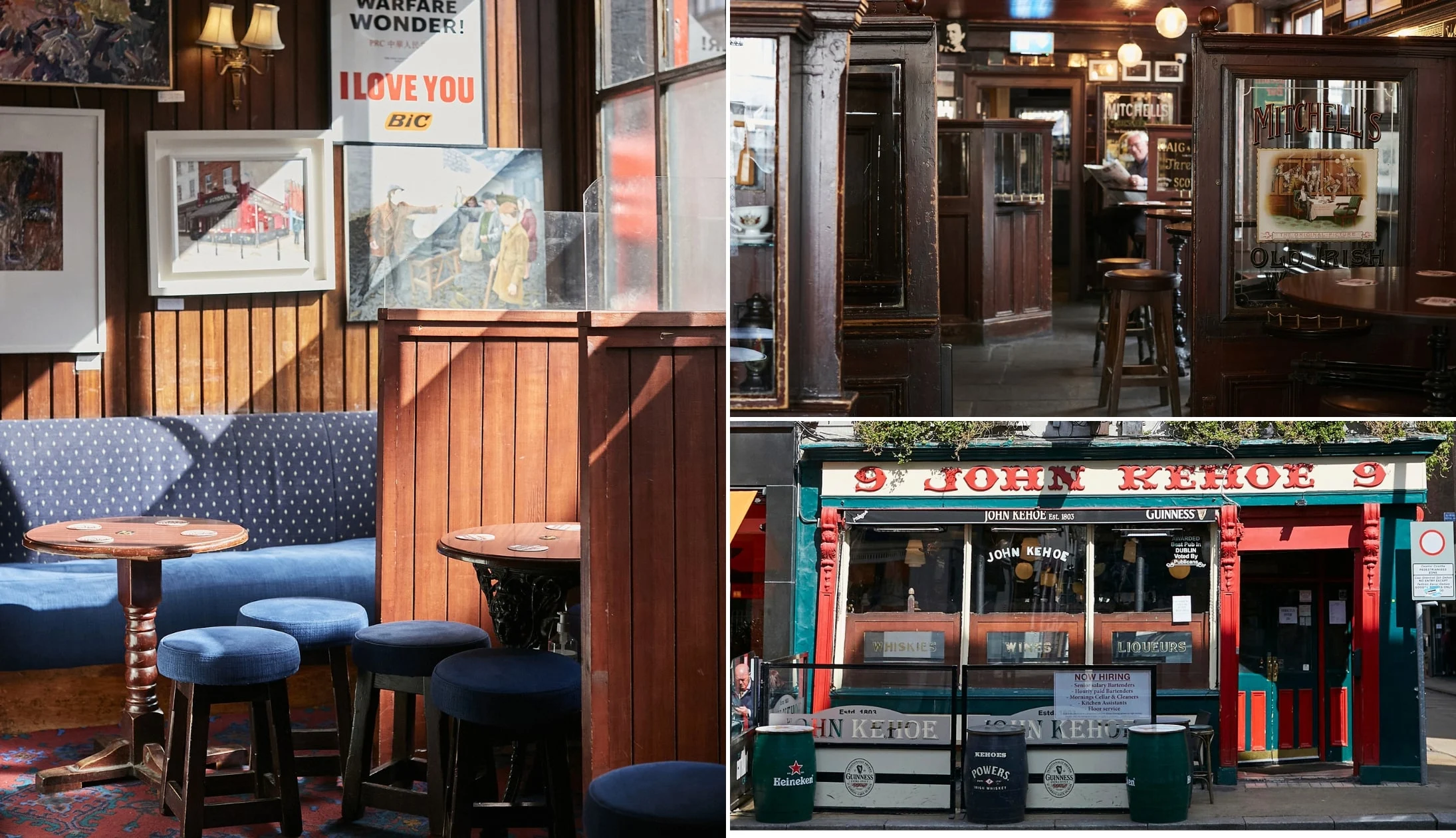
Different trad bars in Dublin. © Tourism Ireland
When you’ve finished at the Guinness Storehouse, you’ll probably be ready for dinner. For our first night in Dublin, we’ve got a few treats lined up.
Our Dublin food recommendations
There’s endless excellent restaurants in Dublin. However, if we had to pick one or two…
The first would be The Bull and Castle – it’s always a good choice and it’s right across the street from the Christ Church Cathedral.
An FX Buckley steakhouse (a Dublin institution), they offer a great range of steaks cooked to perfection, paired with their incredible beef dripping chips.
The Vintage Kitchen is an alternative, but it’s best to book in advance as it’s incredibly popular. A BYOB (bring your own bottle) place, the food is phenomenal, with a small but diverse menu that features classic Irish dishes with a contemporary twist.
Our Dublin pub recommendations
There’s certainly no shortage of great pubs in Dublin. If you’re a fan of old-school pubs, follow our Dublin pub crawl guide – it contains a short route with some of the city’s finest trad bars.
McNeils on Capel Street is an authentic Dublin pub, complete with wood panelling, impromptu folk sessions, and plenty of beers on tap.
The Long Hall is another must-see. Part Victorian time capsule, part vibrant boozer, it enjoys a fantastic atmosphere and is one of the most visually stunning pubs in the city.
You’ll find trad sessions at Pipers Corner every night of the week. O’Donoghues Bar on Merrion Row is another must-visit, with vintage decor and frequent trad sessions. It’s best-known as the home of the Dubliners, who used to play here regularly.
The Celt on Talbot Street is another great choice for live music, and while it’s not always trad, the bands are normally really good.
Day 7: Wicklow’s Wonders
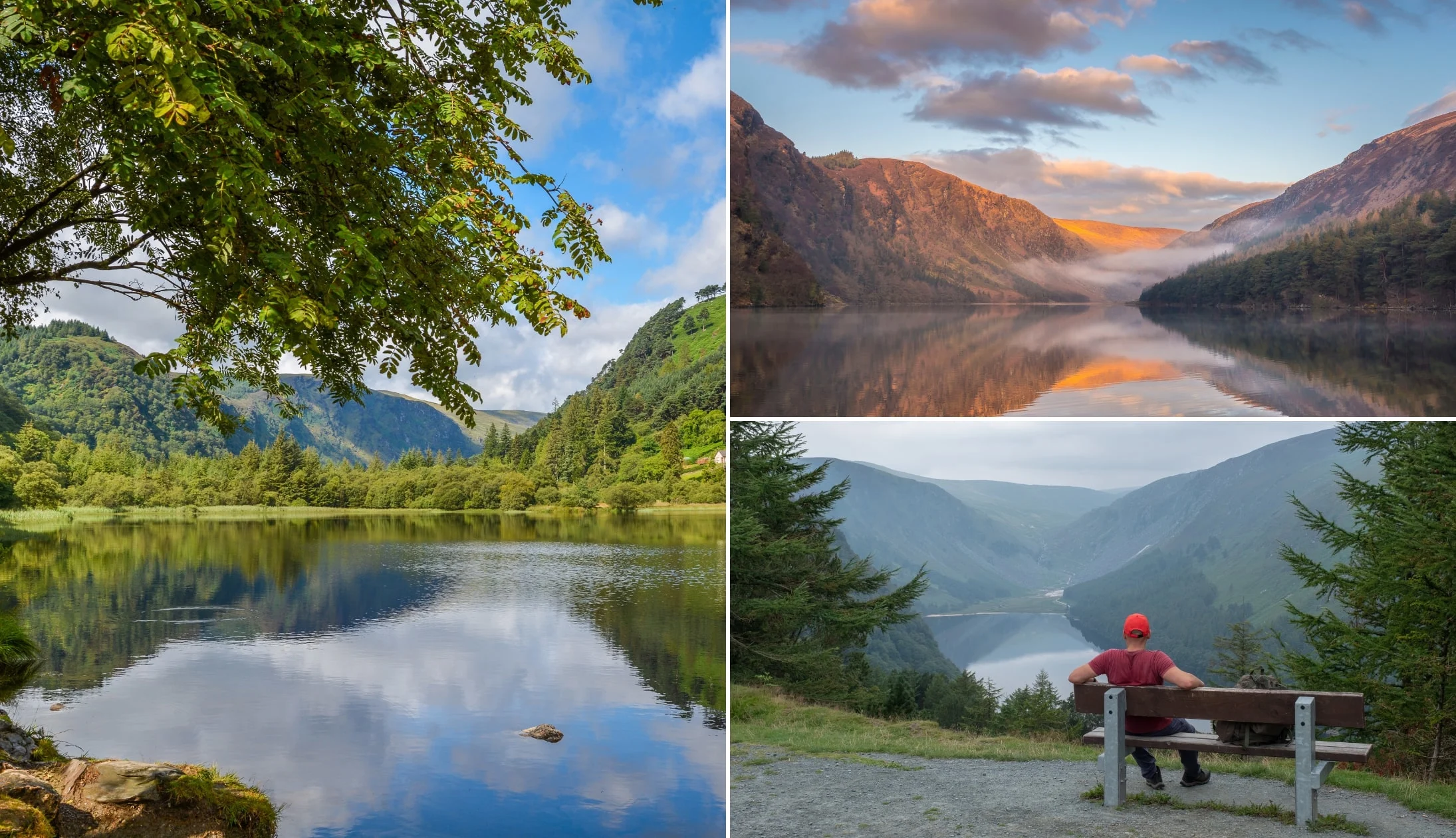
Photos via Shutterstock
Day 7 takes us into the stunning natural beauty of the Wicklow Mountains, just south of Dublin City. We’ll be heading to Glendalough National Park in the heart of the Wicklow Mountains, where you can enjoy a gentle stroll amid some of Ireland’s most spectacular landscapes.
Enjoy a hearty breakfast at your accommodation, or head into town to get food at one of Dublin’s amazing cafes.
We love to go to Lemon Crepe and Coffee Co on Williams Street (it’s just around the corner from the Molly Malone Monument too).
The focus is on pancakes and you can enjoy a wealth of different sweet or savoury toppings. They also do omelettes and other egg dishes, toasts, melts, waffles, and much more. All washed down with a superb cup of coffee.
Stop 1: Lough Tay and optional walks and hikes
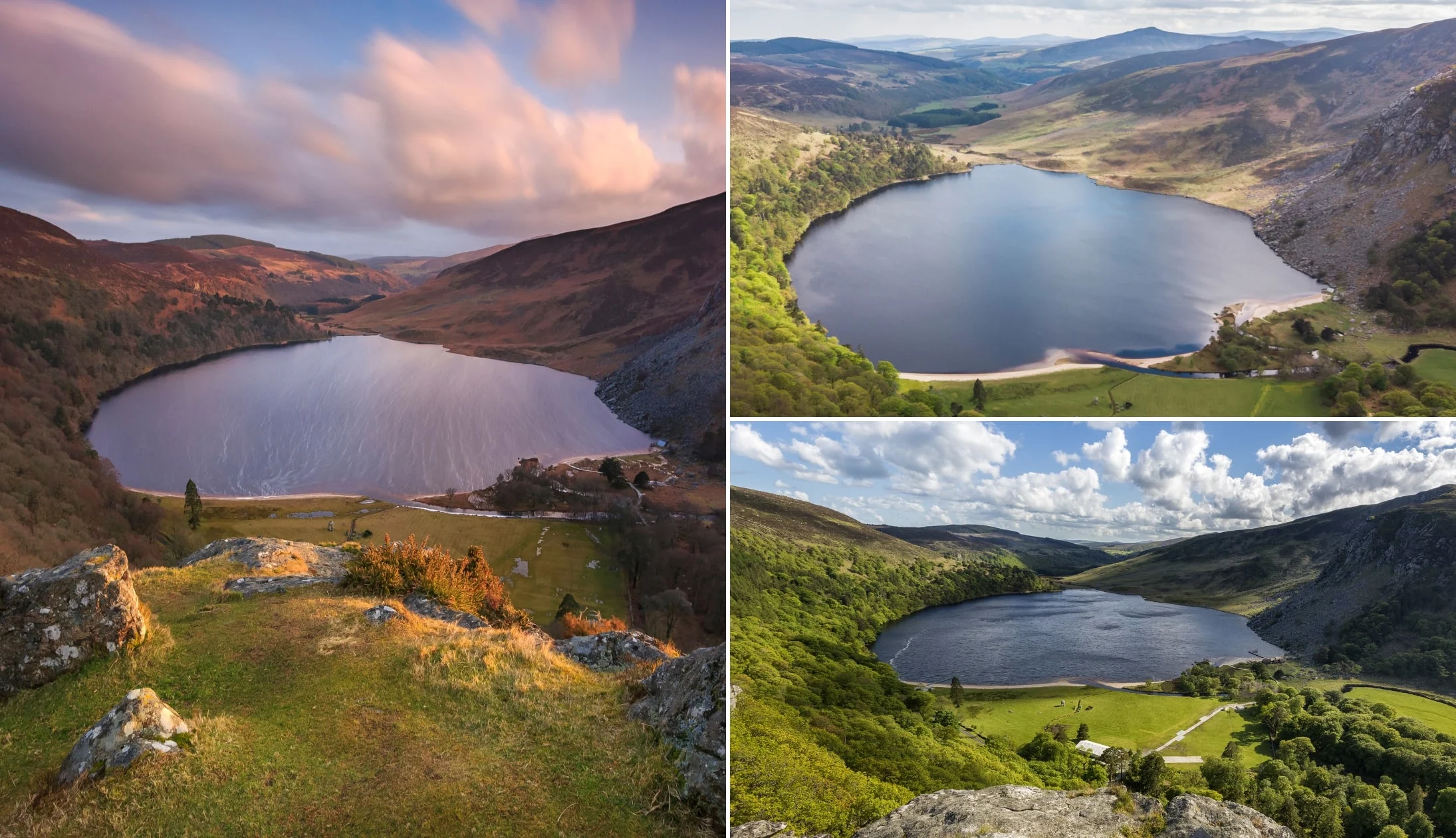
Photos via Shutterstock
Right, you’re going to be taking what’s known as the Sally Gap Drive before you head to Glendalough. This is one of the finest drives in this part of Ireland, so you’re in for a treat.
The first stop is Lough Tay, which more famously known as the Guinness Lake, due to the fact that it’s on the Guinness estate, but also because it looks almost like a pint of Guinness when viewed from above.
There’s a nice viewpoint here (care is needed as there are sheer drops). Now, although we’d recommend you follow the route below and tackle the Spinc hike in Glendalough, there are two great hikes near Lough Tay:
Stop 2: Glenmacnass Waterfall
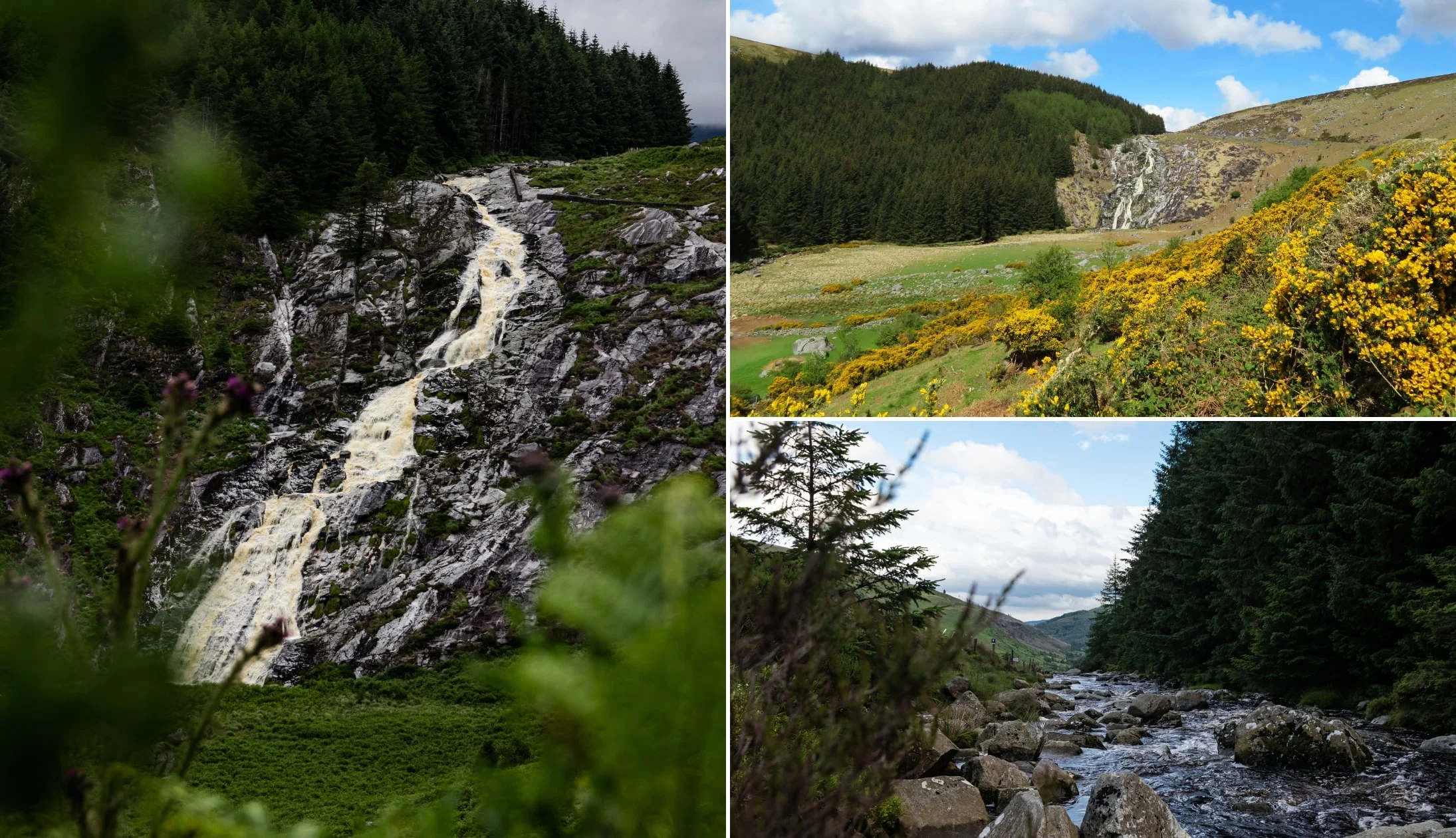
Photos via Shutterstock
Follow the road from Lough Tay and you’ll be treated to glorious mountain scenery, wide open bogland and some roadside Christmas Trees, fully decorated throughout the year (yes, very random!).
Follow the road around to Glenmacnass Waterfall, a beautiful 80-metre cascade that tumbles down the mossy rocks into the river below.
It’s located on the road from Sally Gap to Glendalough and the village of Laragh. There’s a handy car park and from here you can take a short walk to the top of the falls to see them tumbling into the valley below.
Stop 3: Glendalough Visitors Centre and Monastic City
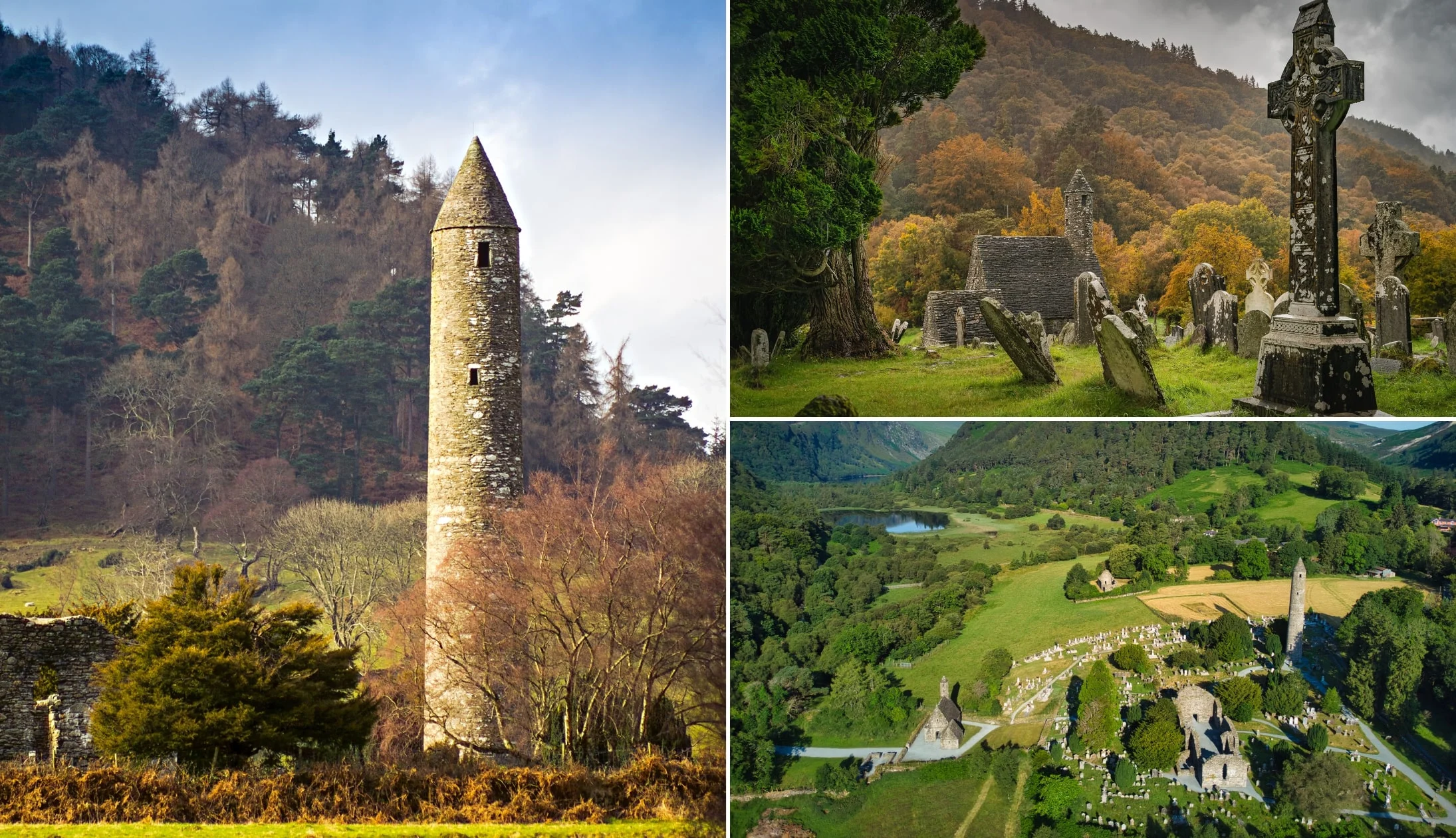
Photos via Shutterstock
Once you arrive at Glendalough, park up at the visitor centre (lower) car park, and pop inside to discover a number of interesting exhibits and displays. These tell the history of the area, while giving a fascinating insight into the natural life that inhabits it too.
Entrance to the visitors centre costs €5 for adults, €3 for children/students and €13 for a family of four, and it’s open daily from 09:30 to 18:00 (peak season) or 17:00 (low season).
Once you’ve finished inside, take a walk outside and discover the fantastic Glendalough Monastic City. Founded by St. Kevin in the sixth century, it’s home to some ancient round towers, churches, and tombs, as well as an extensive graveyard. The ruins are amazingly well-preserved and sit amid some of the finest scenery in Ireland.
Stop 4: Pick a walk in Glendalough
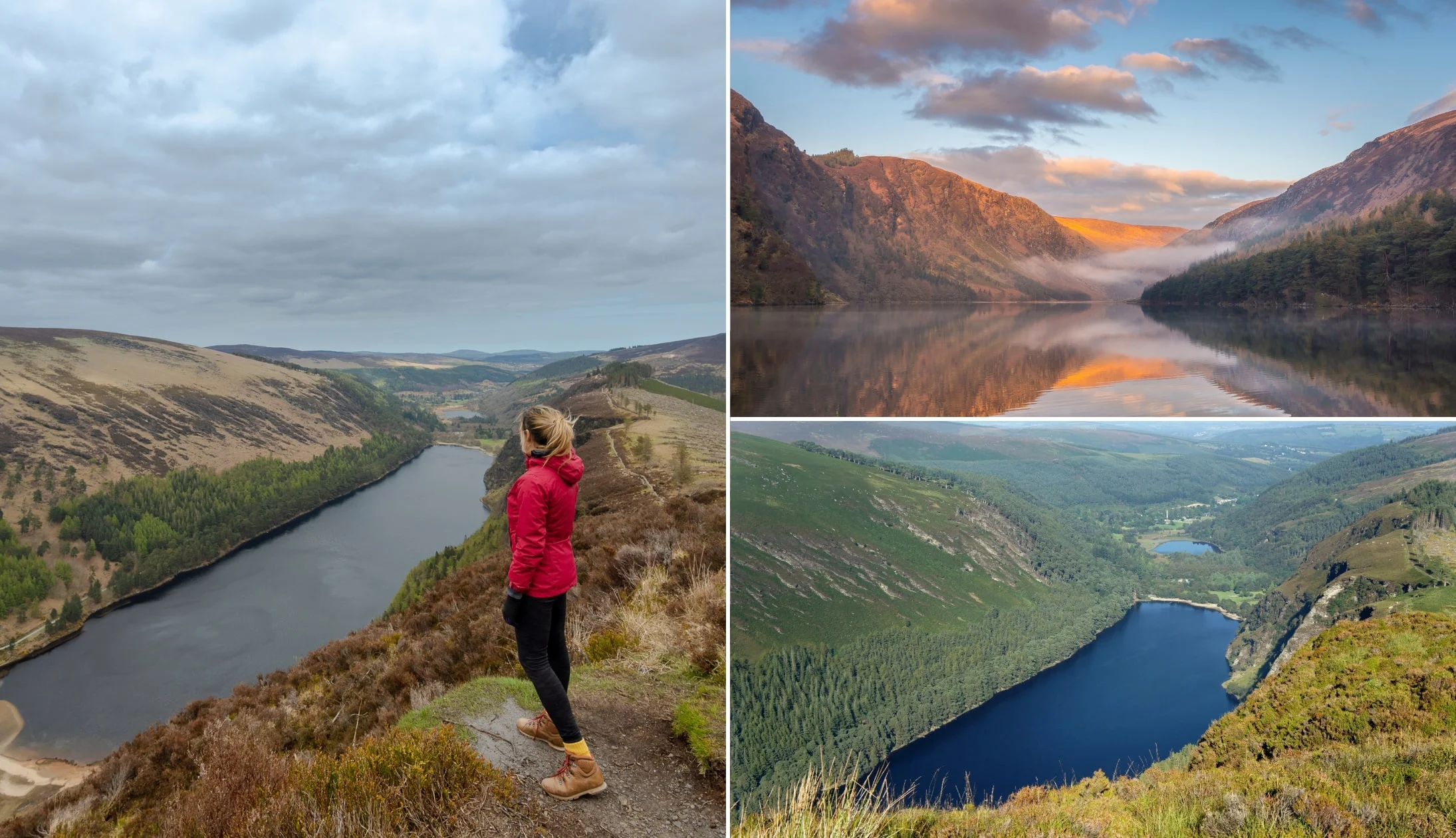
Photos via Shutterstock
There are heaps of walks in Glendalough to choose from, ranging from grand-and-handy to long and toughish.
We’d recommend that you opt for the longer Spinc Loop (pictured above). The Spinc is a gorgeous ridge that overlooks the magnificent Glendalough Valley.
The route we recommend is a moderate to strenuous 9.5 km walk that should take about 3.5 hours to complete. There are shorter walks which you can find here.
Stop 5: A late lunch at the Wicklow Heather

Photo left: The Irish Road Trip. Others: Via Wicklow Heather
Once you’ve finished exploring, you can drive up to the Wicklow Heather for lunch. It’ll take about 5 minutes to get there, and it has an extensive car park. We always recommend the Wicklow Heather, for its cosy atmosphere, quaint decor, and excellent menu. You can choose from a number of traditional Irish dishes, as well as sandwiches, seafood, and much more, including veggie and vegan options.
Stop 6: Powerscourt Waterfall

Photos via Shutterstock
After a tasty lunch, take the scenic 30-minute drive to one of Ireland’s most impressive waterfalls. Powerscourt Waterfall crashes down 121 metres down a craggy cliff face, surrounded by forest, creating a picture-perfect backdrop.
There’s a spacious car park, with toilets and refreshments. From the car park, it’s just a short 10-minute stroll to the waterfall.
If you want to stretch your legs a bit more, there’s a scenic walking trail which is one of the better short walks in Wicklow (it takes about 30 minutes across the river and back). Along the way you can enjoy views of the waterfall from various vantage points and it is worth the extra effort.
Stop 7: Bray seaside stroll

Photos via Shutterstock
There’s nothing like a nice seaside stroll after a day in the mountains, so put “Bray Town Council Car Park” in Google Maps and enjoy the 17-minute drive to the sea. The car park is spacious and pretty cheap at around €0.50 for an hour. A stroll along the promenade takes in fantastic views of Bray Head while the sea softly laps at the beach.
Stop 8: Back to Dublin for the night

Different trad bars in Dublin. © Tourism Ireland
After enjoying a nice walk amid the stunning scenery of the Wicklow Mountains, it’s time to head back to Dublin for the night for dinner, drinks, and maybe a little music.
Our Dublin food recommendations
There’s endless excellent restaurants in Dublin. However, if we had to pick one or two…
The first would be The Bull and Castle – it’s always a good choice and it’s right across the street from the Christ Church Cathedral.
An FX Buckley steakhouse (a Dublin institution), they offer a great range of steaks cooked to perfection, paired with their incredible beef dripping chips.
The Vintage Kitchen is an alternative, but it’s best to book in advance as it’s incredibly popular. A BYOB (bring your own bottle) place, the food is phenomenal, with a small but diverse menu that features classic Irish dishes with a contemporary twist.
Our Dublin pub recommendations
There’s certainly no shortage of great pubs in Dublin. If you’re a fan of old-school pubs, follow our Dublin pub crawl guide – it contains a short route with some of the city’s finest trad bars.
McNeils on Capel Street is an authentic Dublin pub, complete with wood panelling, impromptu folk sessions, and plenty of beers on tap.
The Long Hall is another must-see. Part Victorian time capsule, part vibrant boozer, it enjoys a fantastic atmosphere and is one of the most visually stunning pubs in the city.
You’ll find trad sessions at Pipers Corner every night of the week. O’Donoghues Bar on Merrion Row is another must-visit, with vintage decor and frequent trad sessions. It’s best-known as the home of the Dubliners, who used to play here regularly.
The Celt on Talbot Street is another great choice for live music, and while it’s not always trad, the bands are normally really good.
Day 8: The Boyne Valley and back to Belfast

Photos via Shutterstock
It’s our penultimate day in Ireland, but fear not, there’s still plenty left to see and do! Today, we’ll be heading out of Dublin and returning to Belfast via the beautiful Boyne Valley.
Along the way, we’ll be stopping off at a number of iconic Irish sights before staying one last night in Belfast.
Before we hit the road one last time, be sure to grab a decent breakfast, either at your accommodation or at one of the many superb Dublin cafes that we mentioned before.
You’ll need to book accommodation in Belfast for one more night:
Our Belfast accommodation recommendations
- Budget: Vagabonds Hostel(in the city centre with top reviews) and Amica Guesthouse (short bus/drive from city centre with great reviews)
- Mid-range: Ten Square Hotel and Maldron Hotel Belfast City (both are super central with exceptional reviews)
- Luxury: The Fitzwilliam and The Merchant (both gorgeous, high-end hotels at the heart of the action)
Stop 1: Newgrange

Photos via Shutterstock
Our first stop is a must-see, especially if you’re a history buff. A 45-minute drive from Dublin, the Newgrange Passage Tomb is one of the oldest attractions in Ireland. Dating back to 3,200 BC, it predates the pyramids and offers one of the earliest surviving examples of the triskele, the iconic Celtic three-spiral design. It’s well worth getting there early to avoid the crowds.
There really is nothing else like it, and the best way to see it is by taking a guided tour. It’s well worth the cost and pre-booking is strongly recommended. On the tour, you’ll learn about the fascinating history of the site, while taking in a number of tombs, tunnels, mounds, rock art, and monuments. The visitor centre is also incredible, with a number of displays and exhibits to enjoy. You won’t want to miss this one.
The tour lasts about an hour, though it can easily take three hours to explore the full site.
Stop 2: St Peter’s Church, Drogheda

Photos via Shutterstock
The ancient town of Drogheda, one of the oldest in Ireland, is home to several notable monuments such as old churches, ancient towers and a majestic gate (a remnant of the fortified walls that used to protect the town). It’s 16 minutes away from Newgrange, and just by driving into town you’ll get an eyeful of stunning attractions.
St Peter’s Church is the highlight, a beautiful French Gothic Church built in 1884. It boasts stunning architecture on the outside, but inside you can enjoy fine sculptures, a spectacular marble High Altar, and more than 40 stained glass windows. It’s best-known, however, for housing the shrine of Saint Oliver Plunkett, which contains his preserved head. First arriving from London in 1921, it remains on display to this day.
Located on West Street, if you’re lucky you might find paid street parking near the church. However, you can also park in Duke Street Car Park, Stockwell Lane Car Park, and Drogheda Town Centre Car Park, all of which are close.
Stop 3: Monasterboice

Photos via Shutterstock
Next up, Monasterboice is a stunning early Christian settlement that has been lovingly preserved. It’s about 15 minutes away from St Peter’s Church and there’s a spacious car park right across the road. Dating back to the 5th century, the settlement was founded by Saint Buithe. The well-preserved remains of a 28-metre tall round tower and two magnificent Celtic high crosses are the biggest draws.
In fact, the Cross of Muiredach, or South Cross, is said to be the finest surviving example of a Celtic cross in Ireland. Standing 5.5 metres tall, with incredible intricate carvings, it’s not hard to see why. Enjoy half an hour of wandering around the beautiful grounds, before jumping back in the car and heading to Belfast.
Stop 4: Slane Castle and Hill of Slane
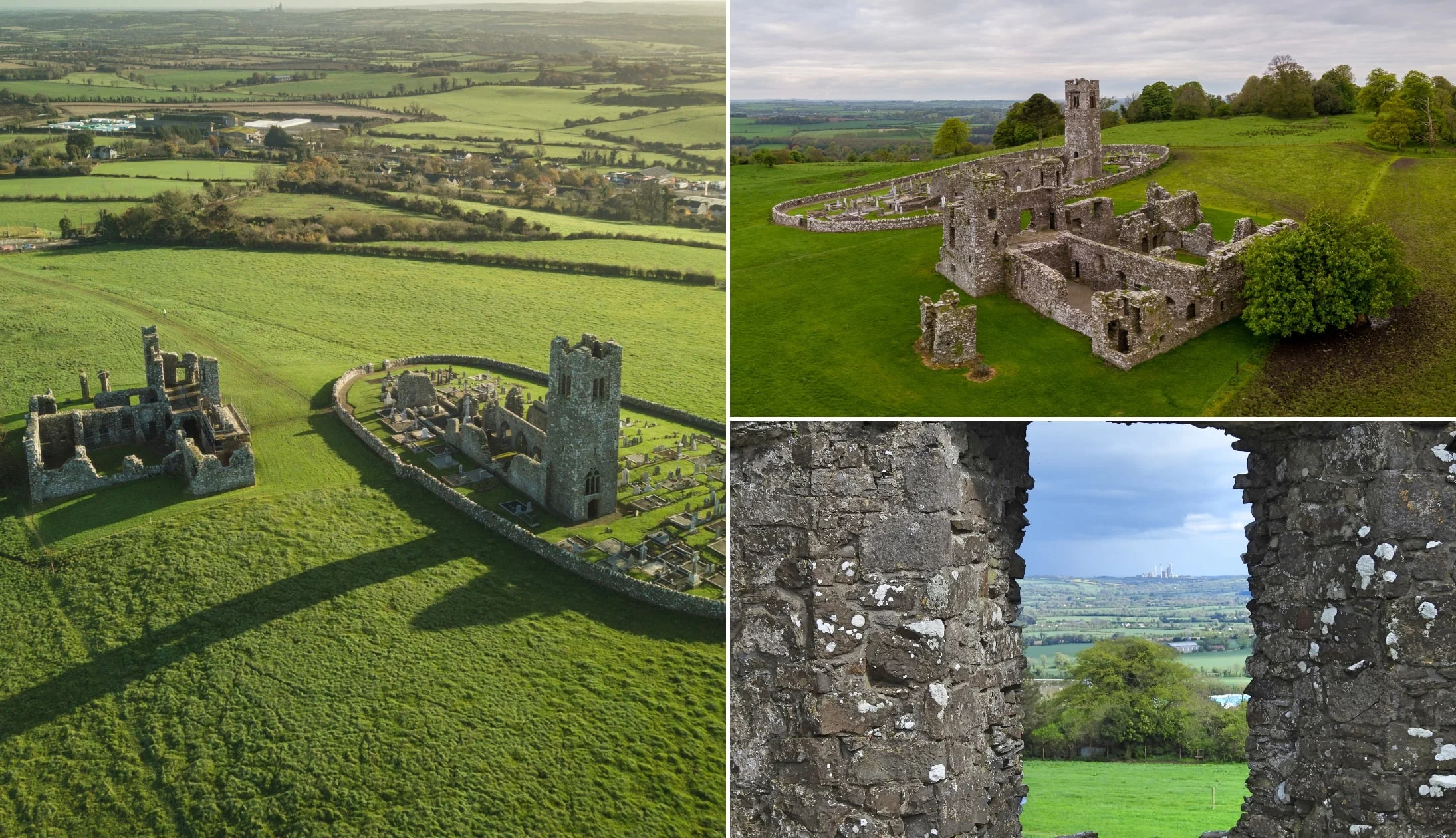
Photos via Shutterstock
Drive another 15 minutes enjoying the gorgeous surroundings, before arriving at the mighty Slane Castle and the Hill of Slane. The 18th-century Slane Castle has lots to offer, and you could easily spend several hours here. There are guided tours at weekends, though you’ll need to book in advance. Otherwise, check out the distillery or tackle the Slane Castle walking trail.
Once you’ve finished at the castle, check out the Hill of Slane, just 4 minutes away. There’s ample parking at the entrance, just follow signs for ‘The yard’ or Abbey View. The hill is steeped in mythology, with legends saying that a king of the Fir Bolg is buried beneath it. A shrine to the Tuatha Dé Danann was erected and the hill has been a hub of religious activity ever since. You can still see the well-preserved ruins of a 16th-century friary church and college to this day. Since the hill towers above the surrounding countryside, the views from the top are gorgeous.
Stop 5: Lunch in Navan

Photos via The Gate Restaurant on FB
All this sightseeing is sure to make you hungry, so next we’re off to the charming town of Navan for a bite to eat. It’s just 15 minutes away from Slane Castle and for parking, head to Trimgate Street (R161), Market Square, or Watergate Street, where you can normally find paid street parking and a wealth of cafes and restaurants. Kennedy Plaza Car Park is an alternative, though with direct access to the town centre, it can get busy.
Once you’re parked up, check out the stylish Chechov’s Cafe on Trimgate Street for a range of tasty sandwiches, wraps, paninis, soups, and a great cup of coffee. Alternatively, Room8 on Watergate Street offers a number of healthy (and not so healthy) hot dishes, alongside their wraps and sandwiches.
Stop 6: Kells Round Tower and High Crosses
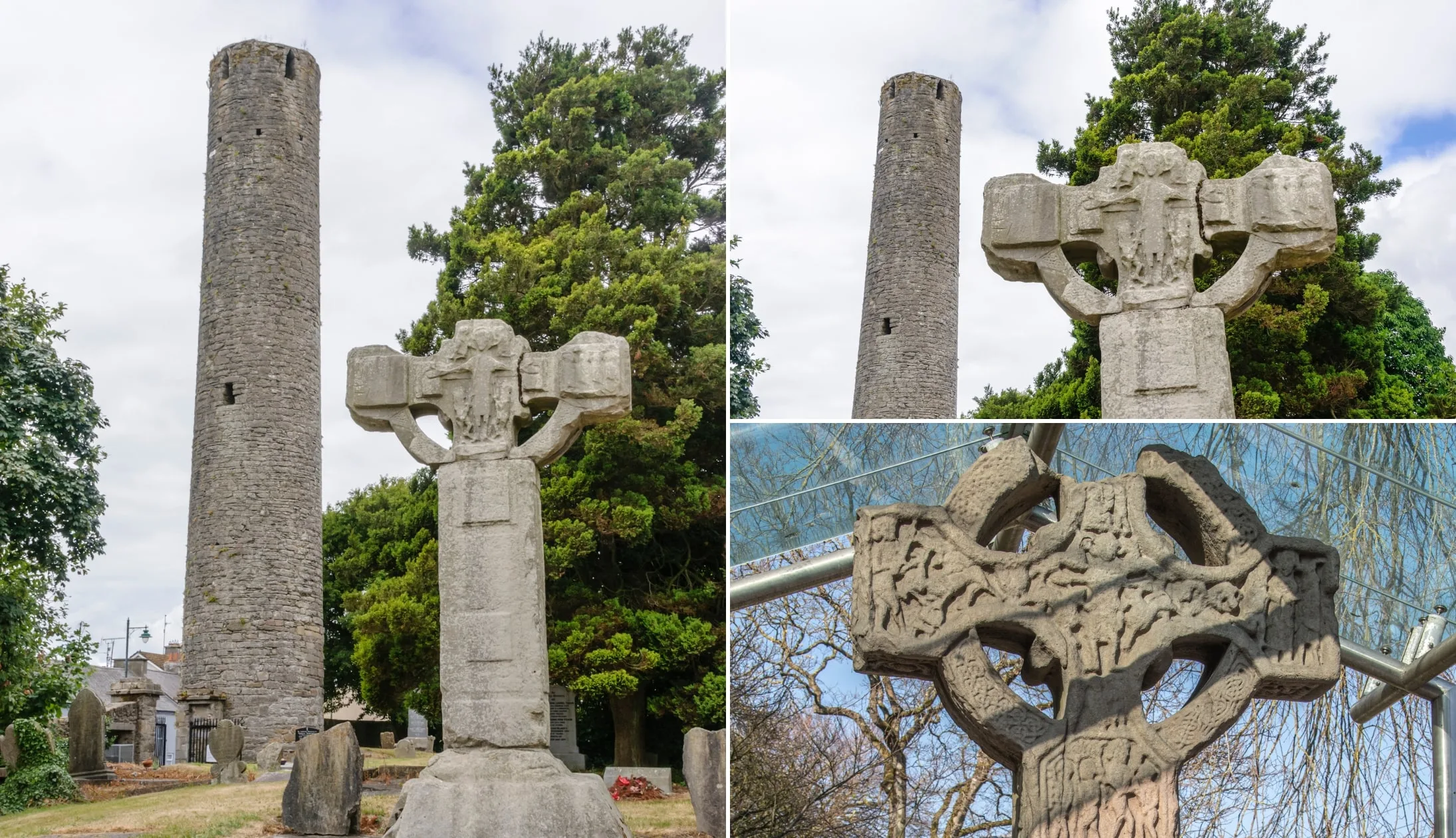
Photos via Shutterstock
Part of Saint Columba’s Church, the Kells Round Tower and High Cross is an extremely popular attraction in Meath. It’s about a 15-minute drive from Nevan, and you’ll find plenty of parking on Cannon Street, pretty much in the shadow of the mighty tower.
An epicentre of the first millennia religious activity, Kells is of huge historical and cultural importance, and it’s humbling to walk among stone structures that have stood proud for hundreds of years. You can’t enter the tower, but you can get up close. The five high crosses may be damaged, but they still showcase the skill of the stonemasons who carved them all those years ago.
Stop 7: Spire of Lloyd

Photos via Shutterstock
Just a 4-minute drive from Kells, the Spire of Lloyd is an 18th-century spire that towers into the Kells skyline. The Spire of Lloyd has a mysterious beginning and has become a symbol of wealth and power. It’s also located near a pauper’s graveyard dating to the Great Famine. You can climb the tower and take in the surrounding view, but only on bank holiday Mondays.
It’s a bit out of the way, but there’s plenty of parking next to the mighty tower. Just take care, as the road in can be a little bumpy.
Stop 8: Trim Castle

Photos via Shutterstock
Continue driving for another 30 minutes through the gorgeous Boyne Valley countryside before arriving at our next stop, Trim Castle. The castle is open seven days a week, between 10 am and 5 pm and an adult ticket will cost you €5, a senior ticket is €4 and child and student tickets are €3. Like Bective Abbey, scenes of the movie Braveheart were filmed at Trim Castle.
Trim Castle dates back to the 12th century and is steeped in history as the site of many battles and raids. Despite its tumultuous history, it remains in great shape, with an intact tower house and walls. You can take a guided tour that lasts about 45 minutes. Along the way, you’ll explore the various halls and chambers before heading to the top of the castle to admire the amazing views of the surrounding town and countryside. If you don’t fancy going inside, you can enjoy a couple of lovely riverside walks around the outside of the castle.
There’s a handy pay and display car park at the castle, although the maximum stay is two hours. If that’s full, there’s another pay-and-display car park opposite the castle on the humorously-named Finnegan’s Way, just off Castle Street. You can easily spend 30 to 60 minutes enjoying Trim Castle.
Stop 9: Bective Abbey
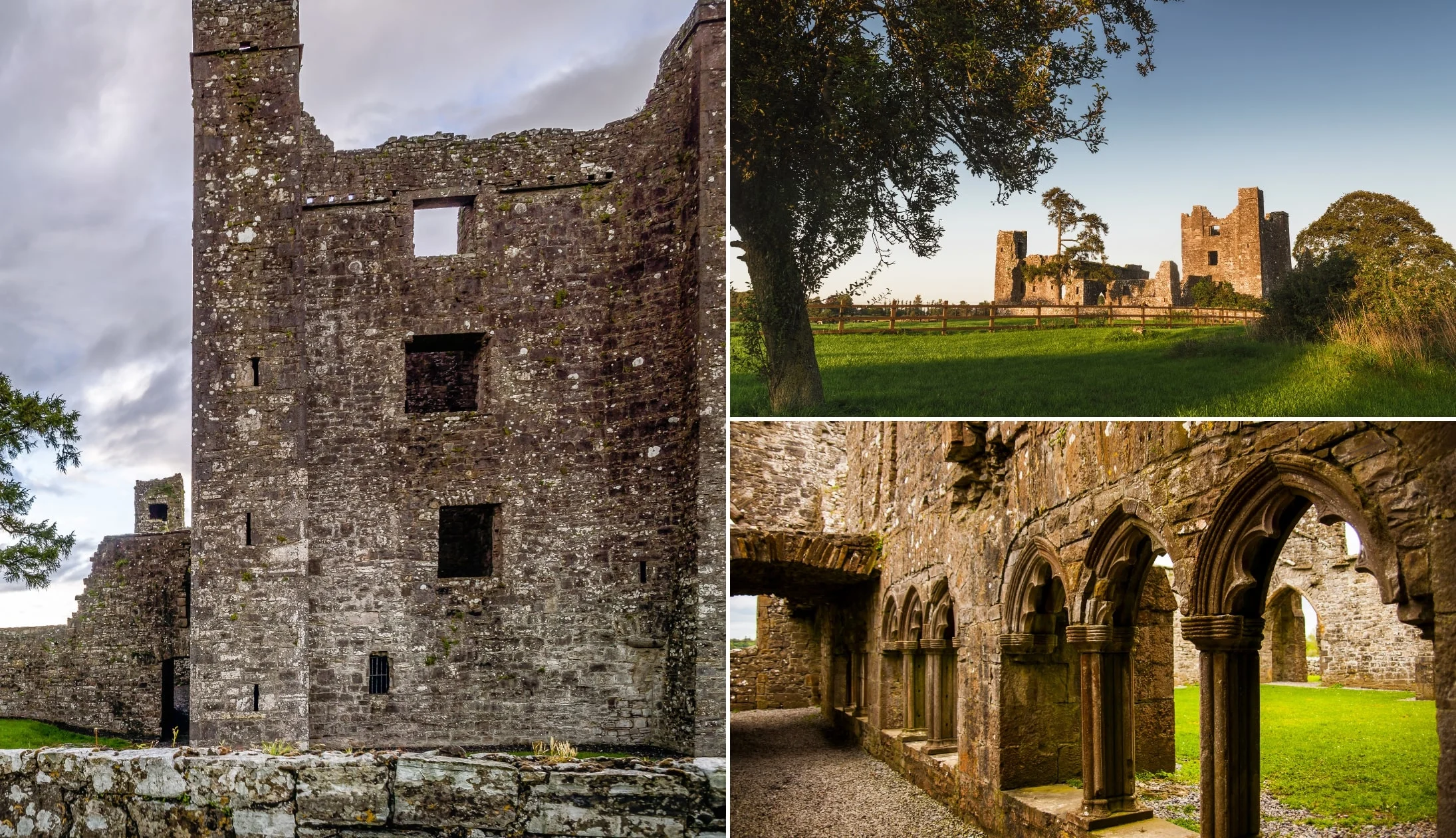
Photos via Shutterstock
Just a ten-minute spin away from Trim Castle, Bective Abbey dates back to 1147 and was Ireland’s second Cistercian Abbey. The ruins are remarkably well-preserved, though most of what remains date back to the 13th and 15th centuries. In particular, the cloister stands proud to this day. In fact, you might recognize it from the movie Braveheart.
You’ll see it clearly from the road, an impressive and iconic structure standing proud among the lush green surroundings. There’s a handy little car park, and from there it’s just a short walk to the ruins. It’s free to visit, and you can walk among the ruins at your leisure, reading the information panels to learn more about the history.
Stop 10: Hill of Tara
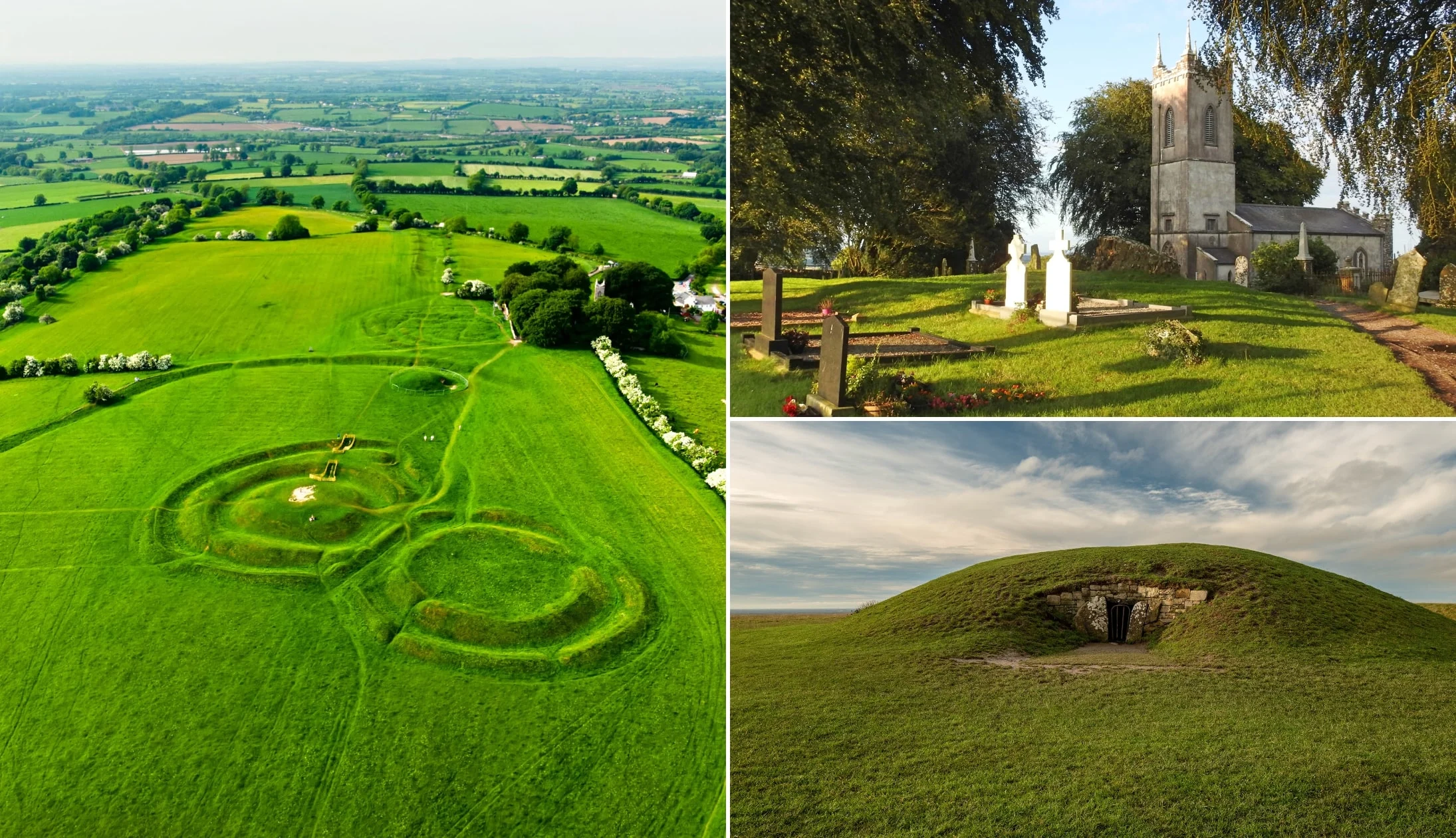
Photos via Shutterstock
Our last stop for today is the iconic Hill of Tara, just a 12-minute drive from Bective Abbey. Dating back to the Iron Age, this hilltop is a veritable archaeological treasure trove and was formerly the seat of the High Kings of Ireland. The area is awash with ancient monuments, including passage tombs and burial mounds that date back thousands of years.
There’s an extensive car park on the side of the road, and you can enjoy a nice walk up onto the hills to get a better look at the various ancient sites. The surrounding scenery is also breathtaking, and you can see why it was so important to the High Kings of Ireland. If you fancy a coffee, drop by Maguires Cafe and Gift Shop to refuel.
Stop 11: Belfast for the night

Photo left: Silvia Franceschetti (CC BY-SA 3.0). Others via Bittle’s Bar on FB
It’ll take about an hour and forty minutes to reach Belfast from the Hill of Tara. Once you arrive, check into your accommodation, freshen up, and hit the town for your last night in Ireland.
You’ll find tons of options for food, drink, entertainment, and plenty of live music here, so whether you go back to your accommodation to freshen up first or head straight out is up to you.
Our Belfast food recommendations
There’s some outstanding restaurants in Belfast City. First up, Deanes is a Belfast institution and a must-visit while you’re in the city. There are three venues to choose from, each focusing on something different; Deanes Meat Locker, Deanes Love Fish, and Deanes at Queens.
Whichever you choose, you’re in for a fine feed. EDO is another favourite of ours, a stunning tapas and cocktail bar with incredible sharing platters.
Or, for a fancy meal, head to The Ginger Bistro, near the Belfast Opera House. Their menu is out of this world, though that’s no surprise when you consider it was voted the best restaurant in Northern Ireland.
Our Belfast pub recommendations
There are countless incredible pubs and bars in Belfast for a tasty after-dinner tipple. Check out traditional options like the unmistakable Bittles Bar, with its stunning range of local beer and Irish whisky.
The Duke of York is another old-school boozer, walls adorned with knick-knacks from yesteryear and serving up a fine pint of Guinness.
Finally, we couldn’t forget Madden’s Bar, a cosy, traditional pub complete with a roaring wood-burning stove and a friendly atmosphere. Somewhat overlooked, it’s a hidden gem, beloved by those in the know!
Traditional musicians from across Ireland come to play at Kelly’s Cellars every Tuesday, Wednesday, Thursday, and Saturday.
Other fantastic options for music include Fibber Magees, another charmingly old-fashioned pub with a lively atmosphere, and the John Hewitt.
Day 9: Belfast and rounding up your trip

Photos via Shutterstock
Today’s the day you fly home and leave Ireland behind. Before you head to the airport, enjoy one last full Irish breakfast—you’ll not find white pudding anywhere else—and if time allows, check out some of the Belfast attractions that you didn’t get around to yet.
Cheers for joining us on this Irish Road Trip. We hope you had fun, made friends, and go home with fond memories of our humble island. May the road rise to meet you.
And that’s a wrap on this road trip
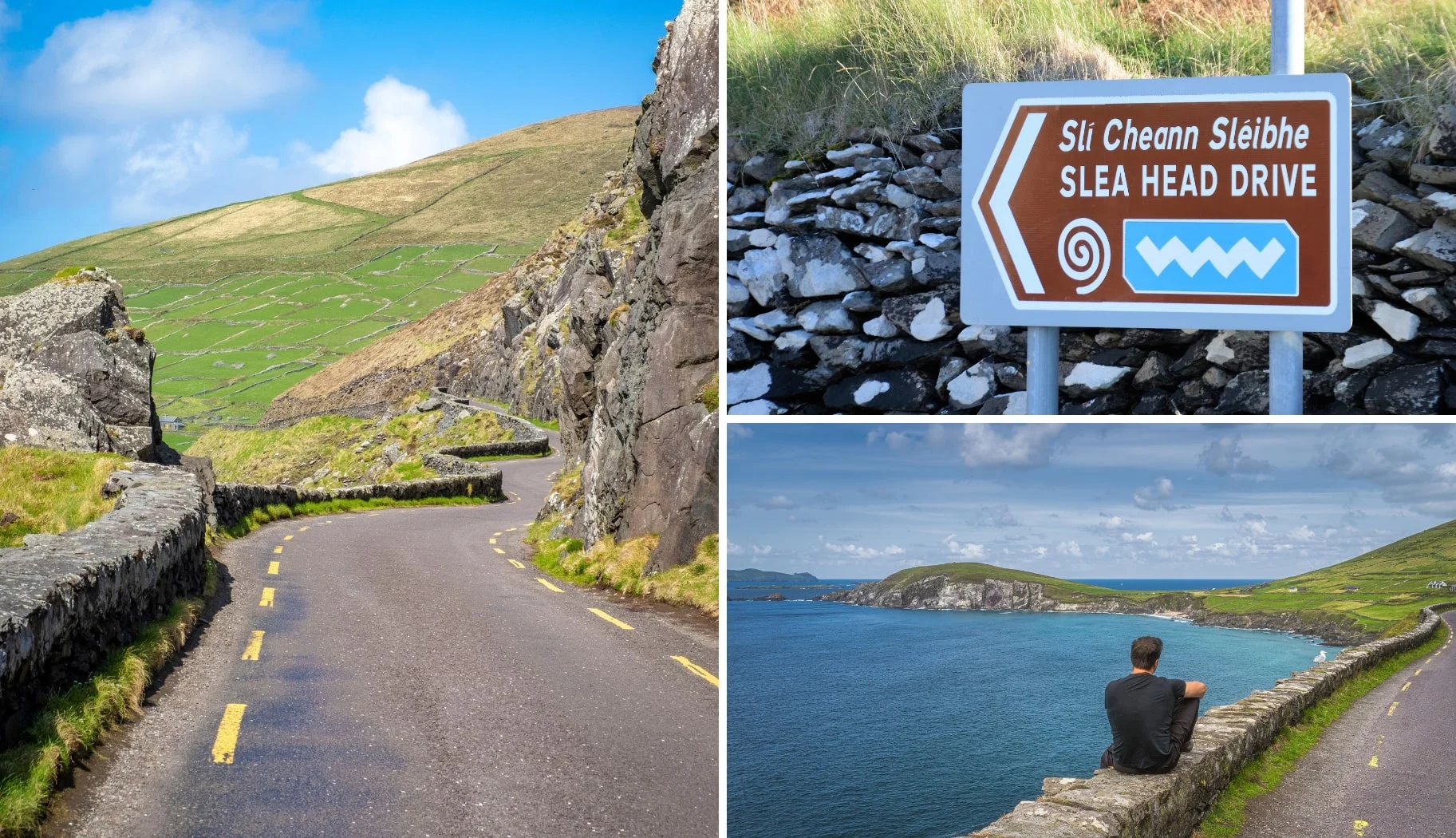
Photos via Shutterstock
We hope you found the above road trip guide useful. If you have any questions, ask in the comments below and we’ll do our best to help.
Or, if you’d like to browse our other Irish Road Trip itineraries, visit our Road Trip Hub – cheers!
Keith O’Hara has lived in Ireland for 35 years and has spent most of the last 10 creating what is now The Irish Road Trip guide. Over the years, the website has published thousands of meticulously researched Ireland travel guides, welcoming 30 million+ visitors along the way. In 2022, the Irish Road Trip team published the world’s largest collection of Irish Road Trip itineraries. Keith lives in Dublin with his dog Toby and finds writing in the 3rd person minus craic altogether.

